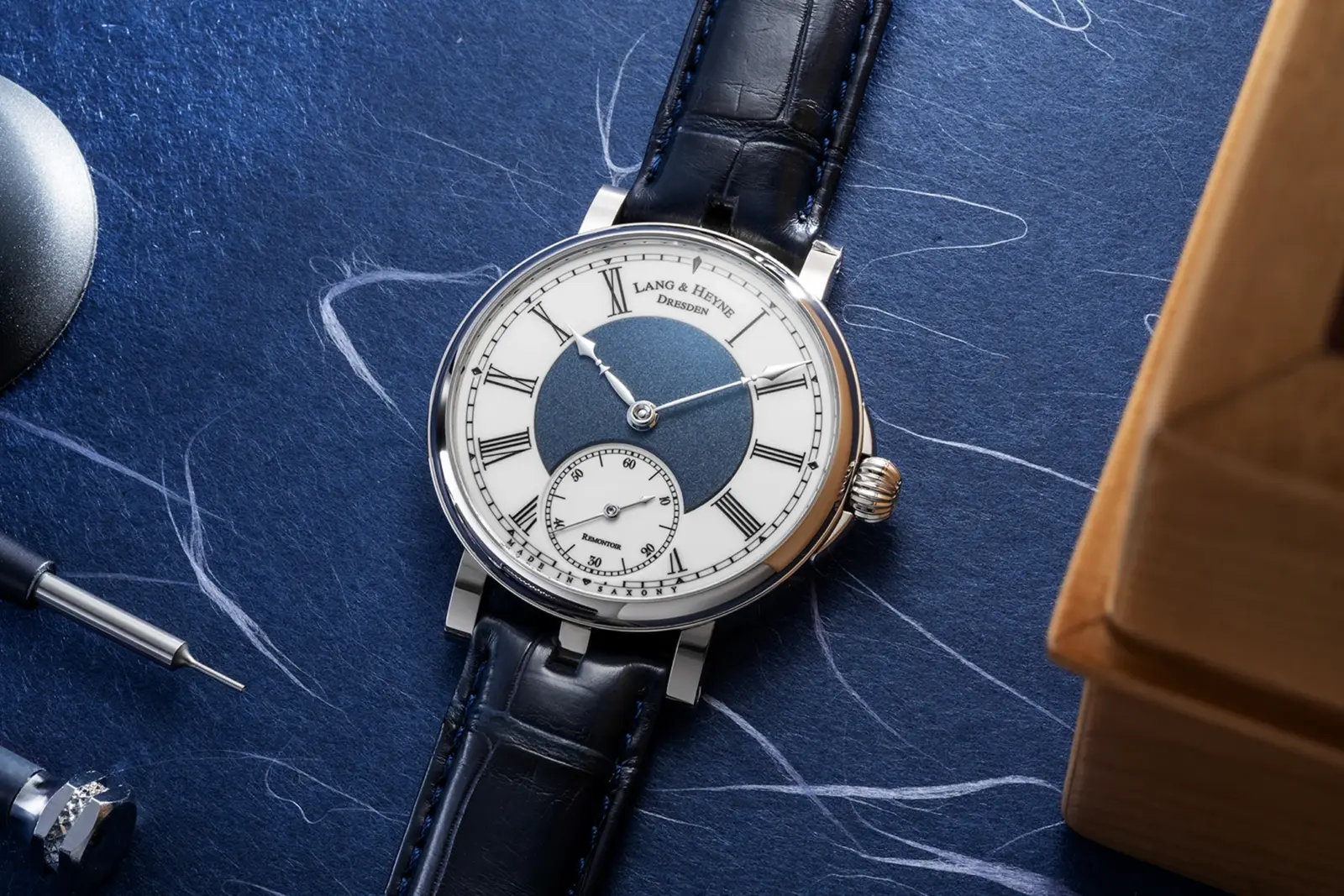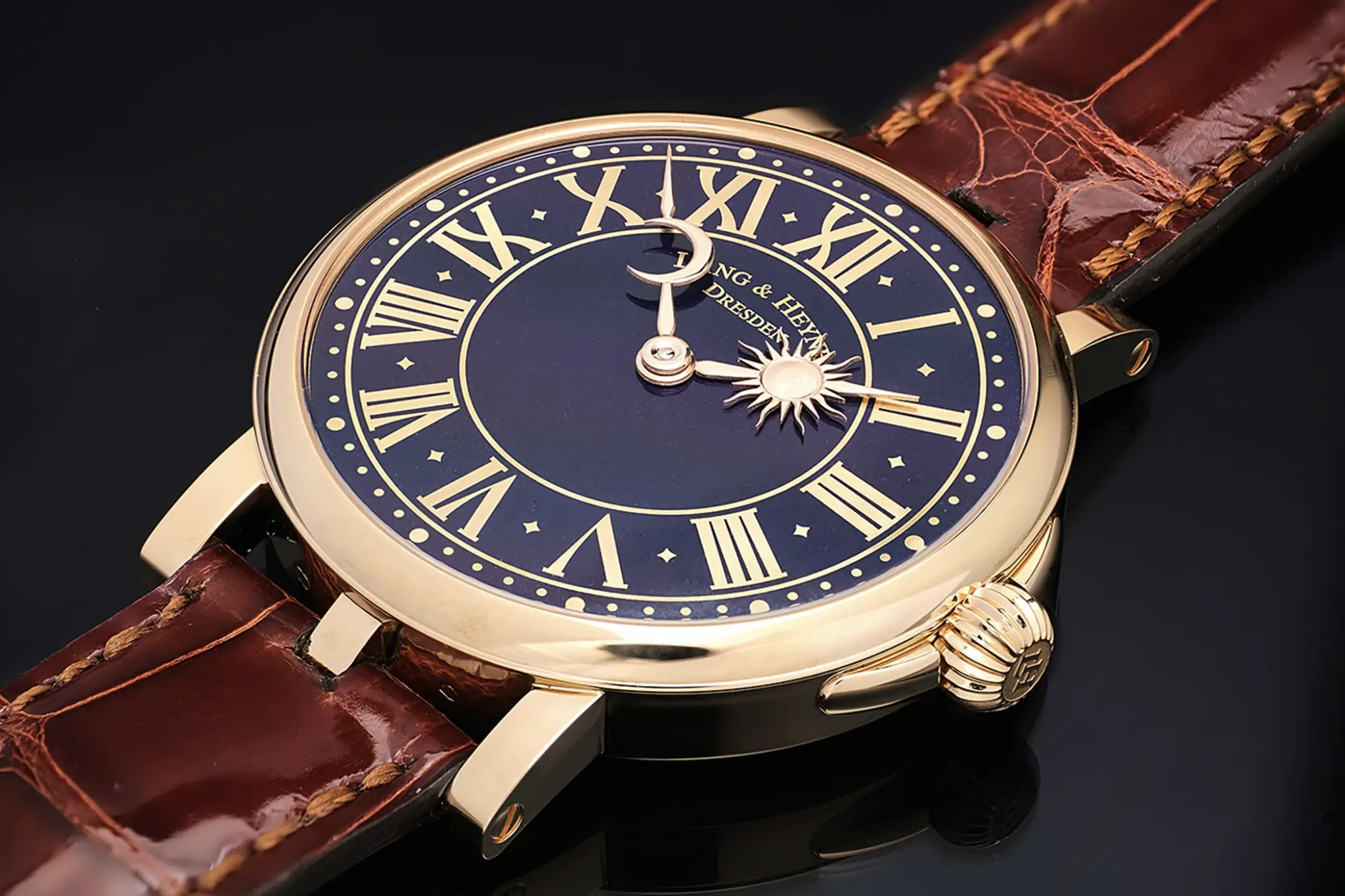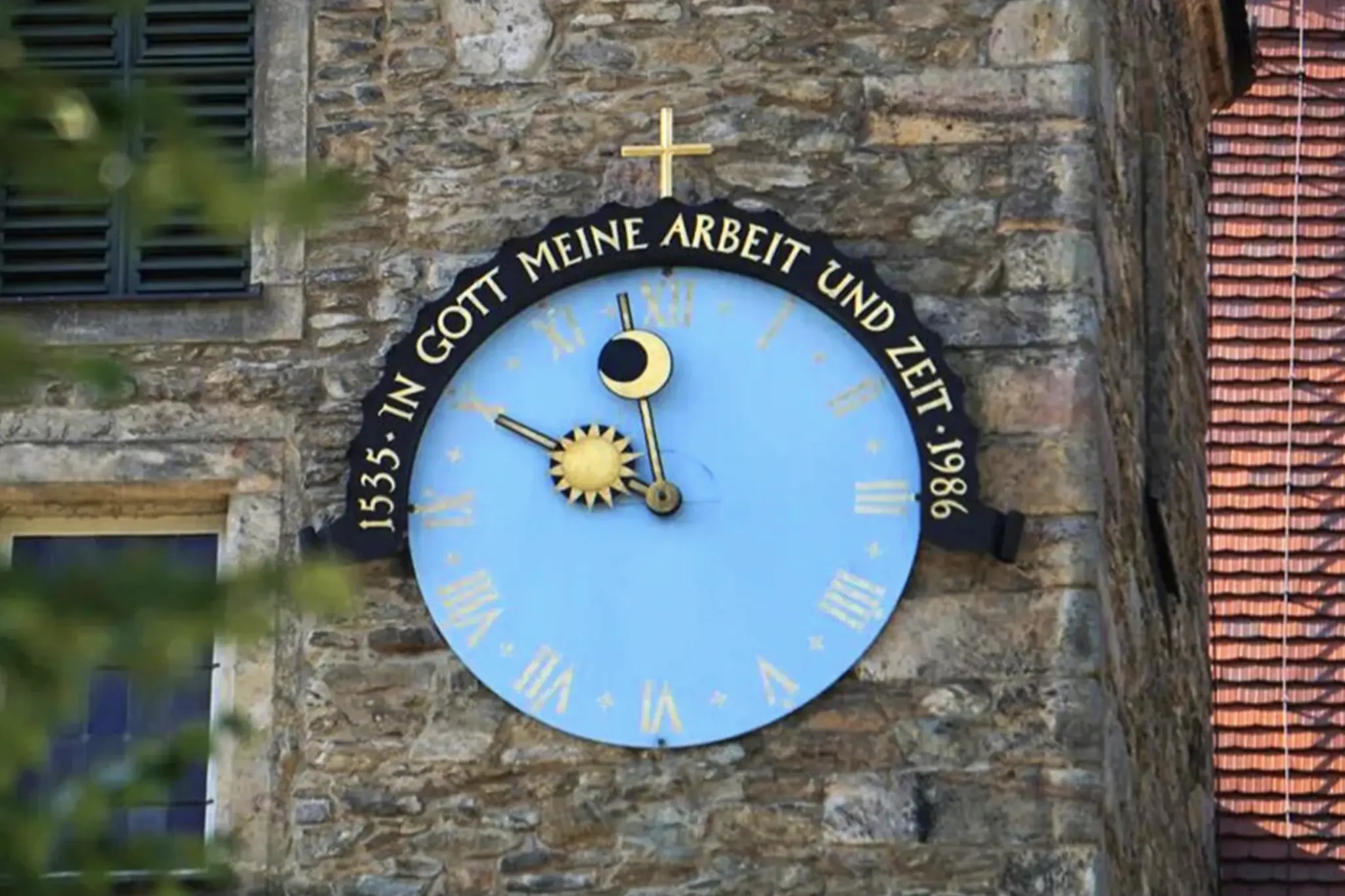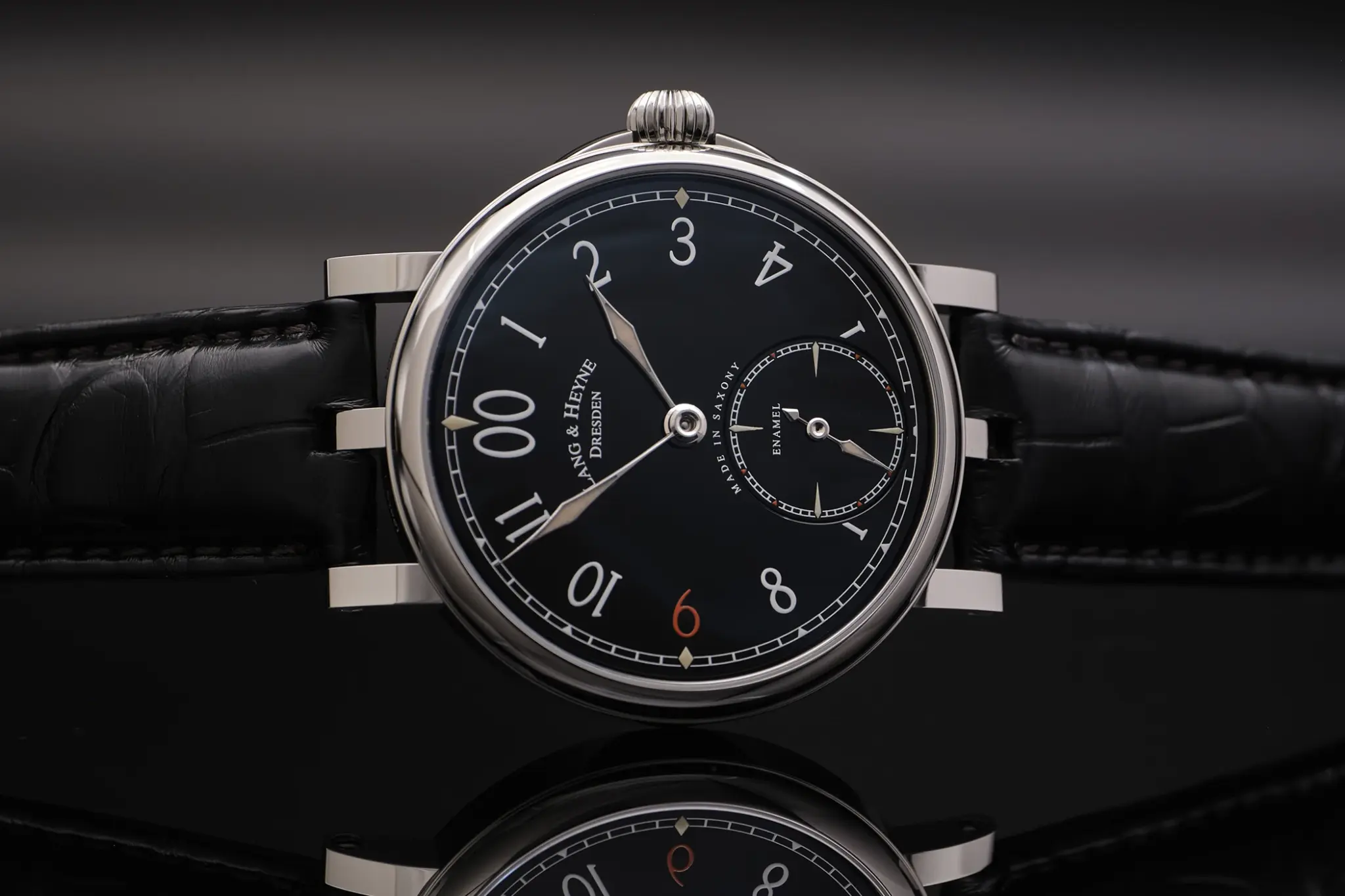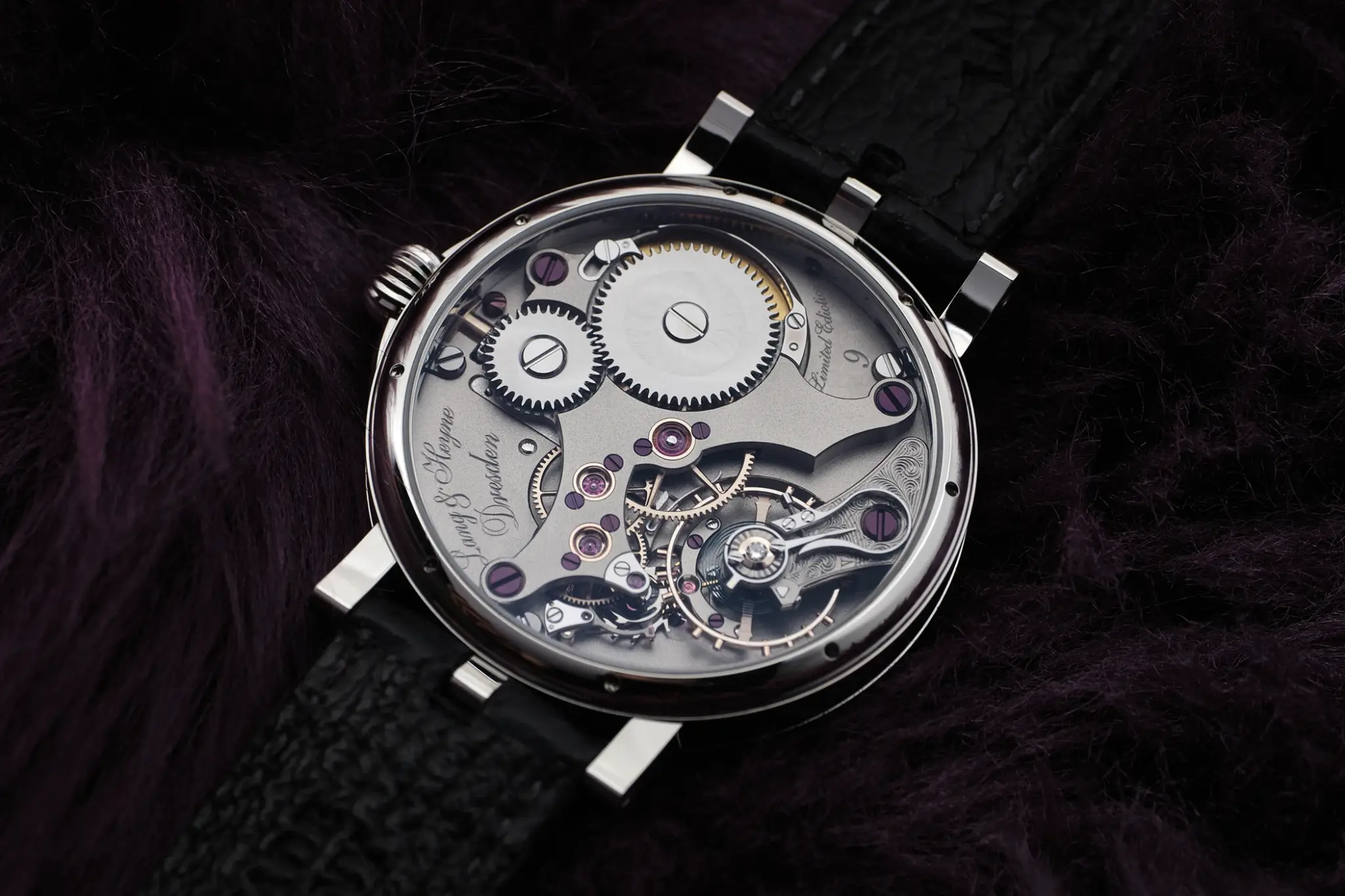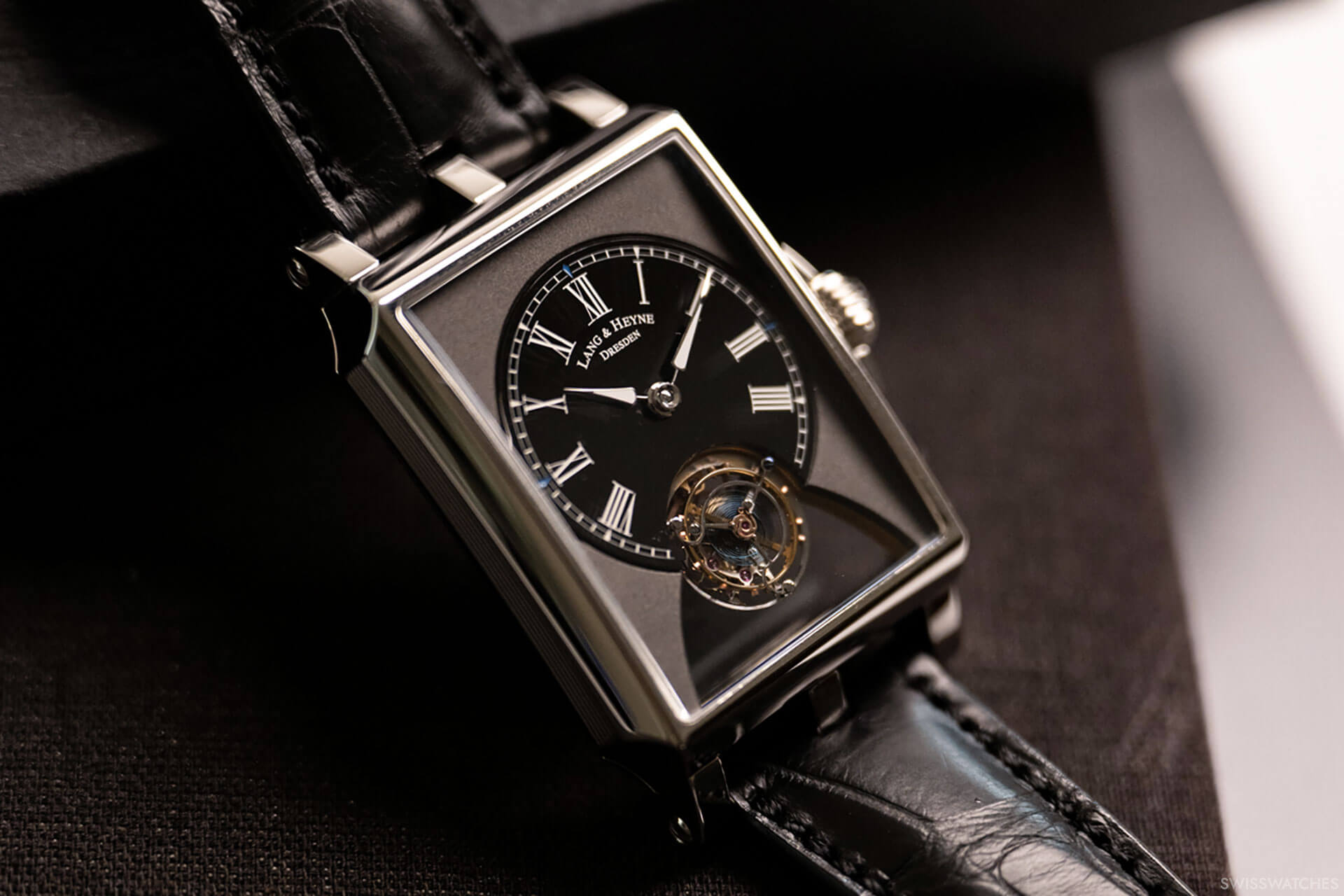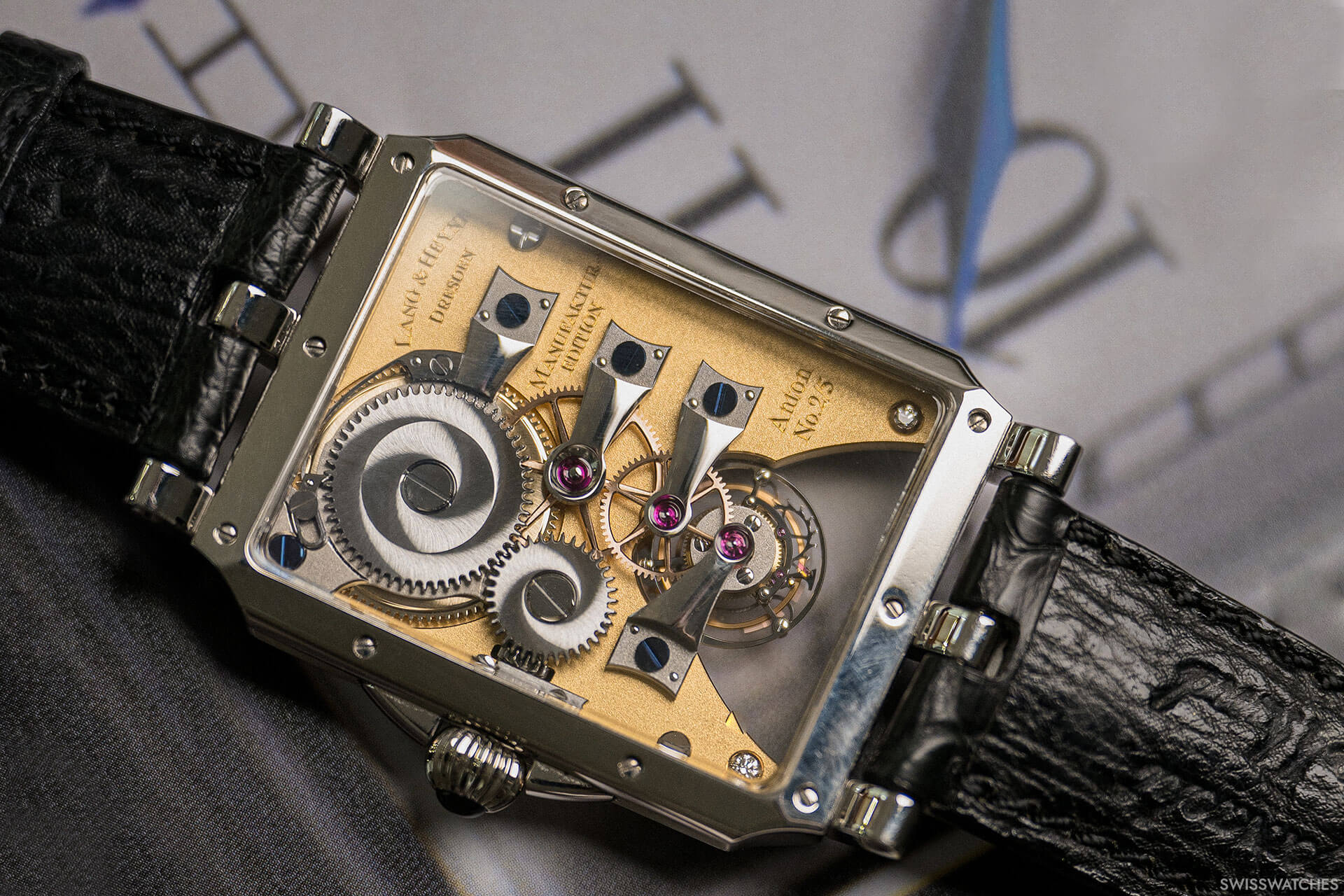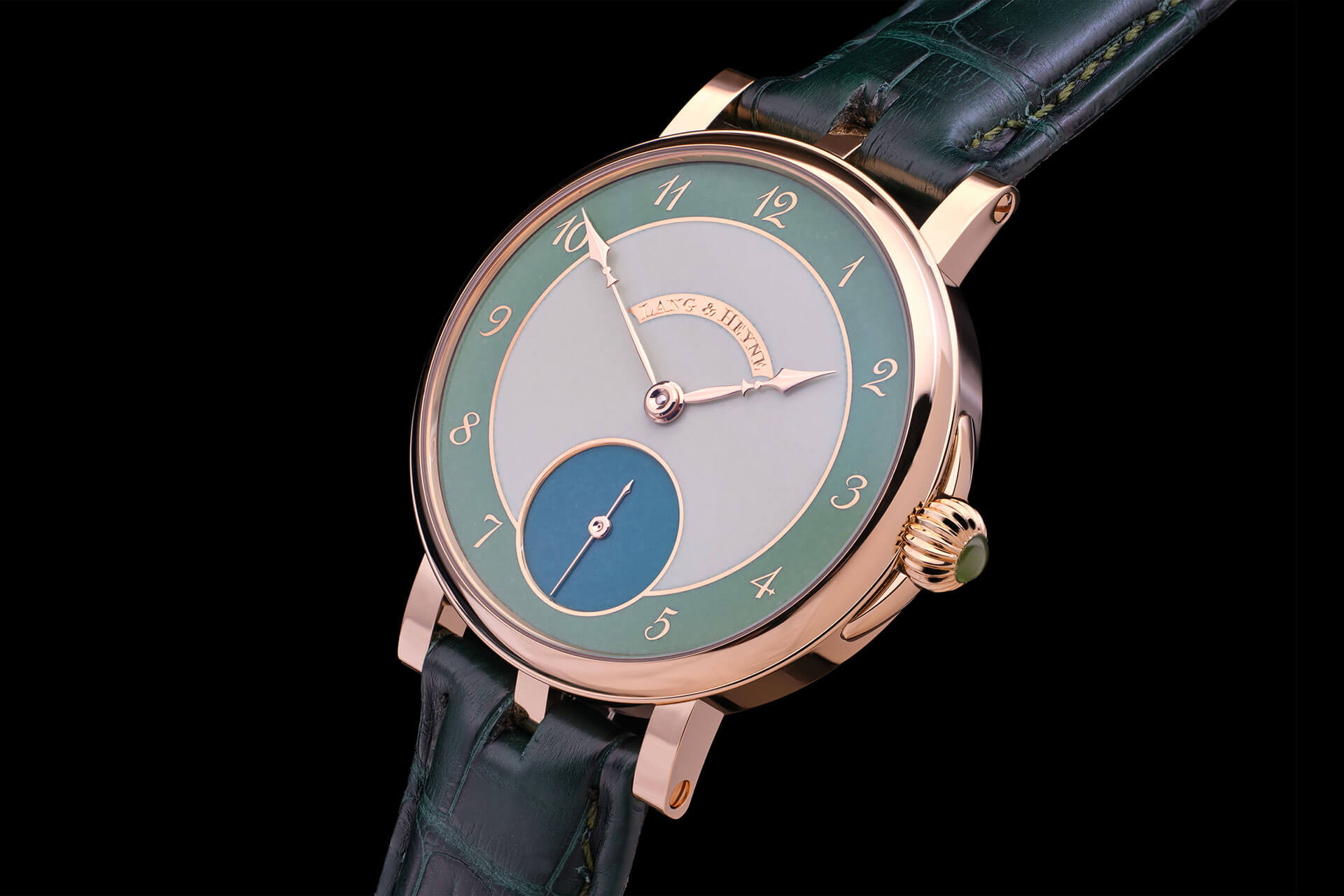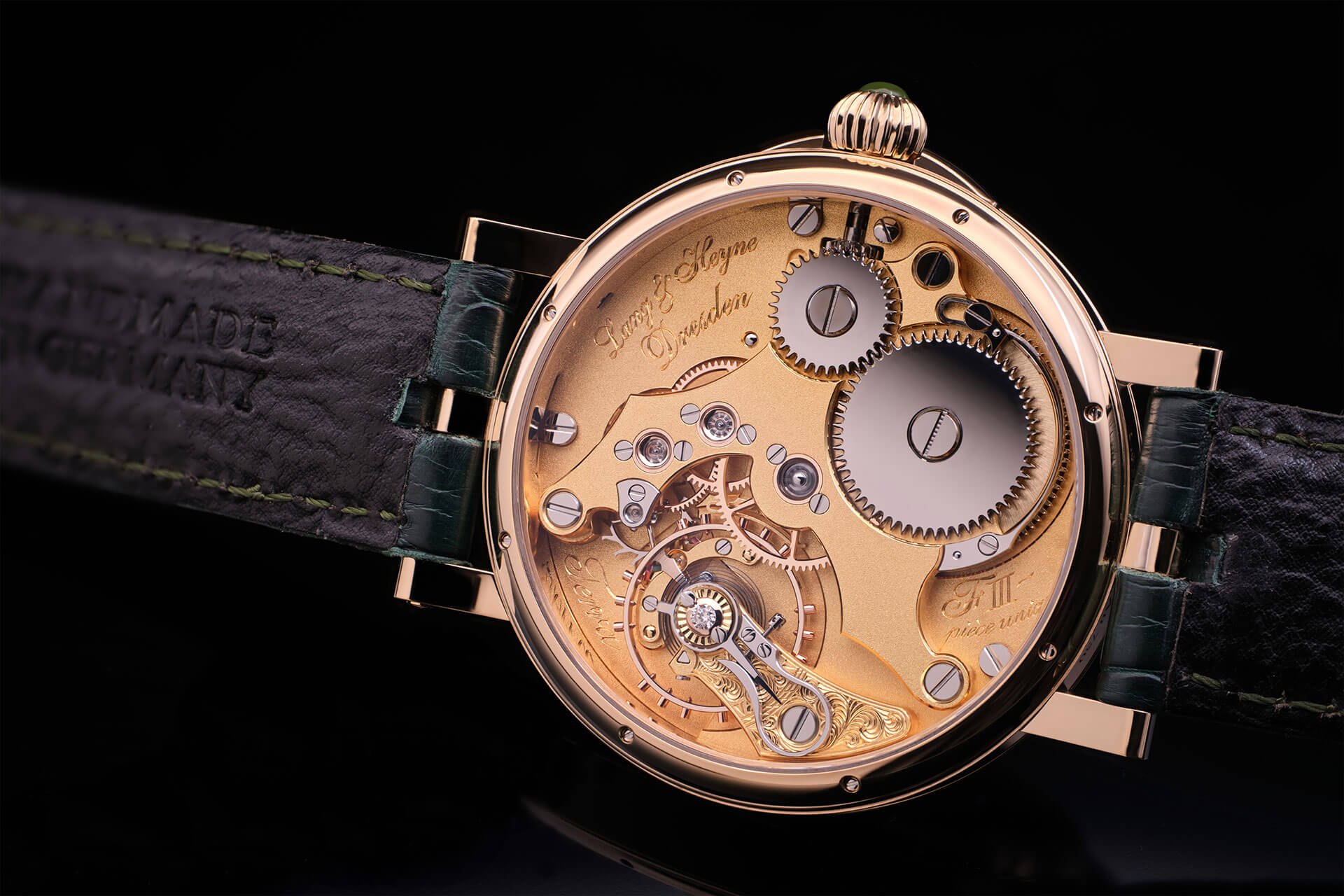It is a watch brand that is actually only known to true connoisseurs: Lang & Heyne from Radeberg near Dresden. The timepieces are not only technically extremely sophisticated with their in-house developed and produced movements, but also finished with a remarkable attention to detail. We wanted to find out more about this small watch manufacture, which is in demand amongst top collectors worldwide, yet produces only 150 watches a year – by hand, of course, with a production depth of over 90 percent for the movement. Back in summer, we were able to visit the Lang & Heyne manufacture in Radeberg, which is located in the listed Todenmühle on the outskirts of Dresden. You can read our detailed article on the manufacture here. In it, we present not only the founding history and all the details about the production of the watches and nine in-house calibres to date, but also the core collection, which are all named after kings and family members of the 800-year Saxon history of the House of Wettin: Hektor, Georg, Anton, Friedrich I, II and III, Friedrich August I and Johann.
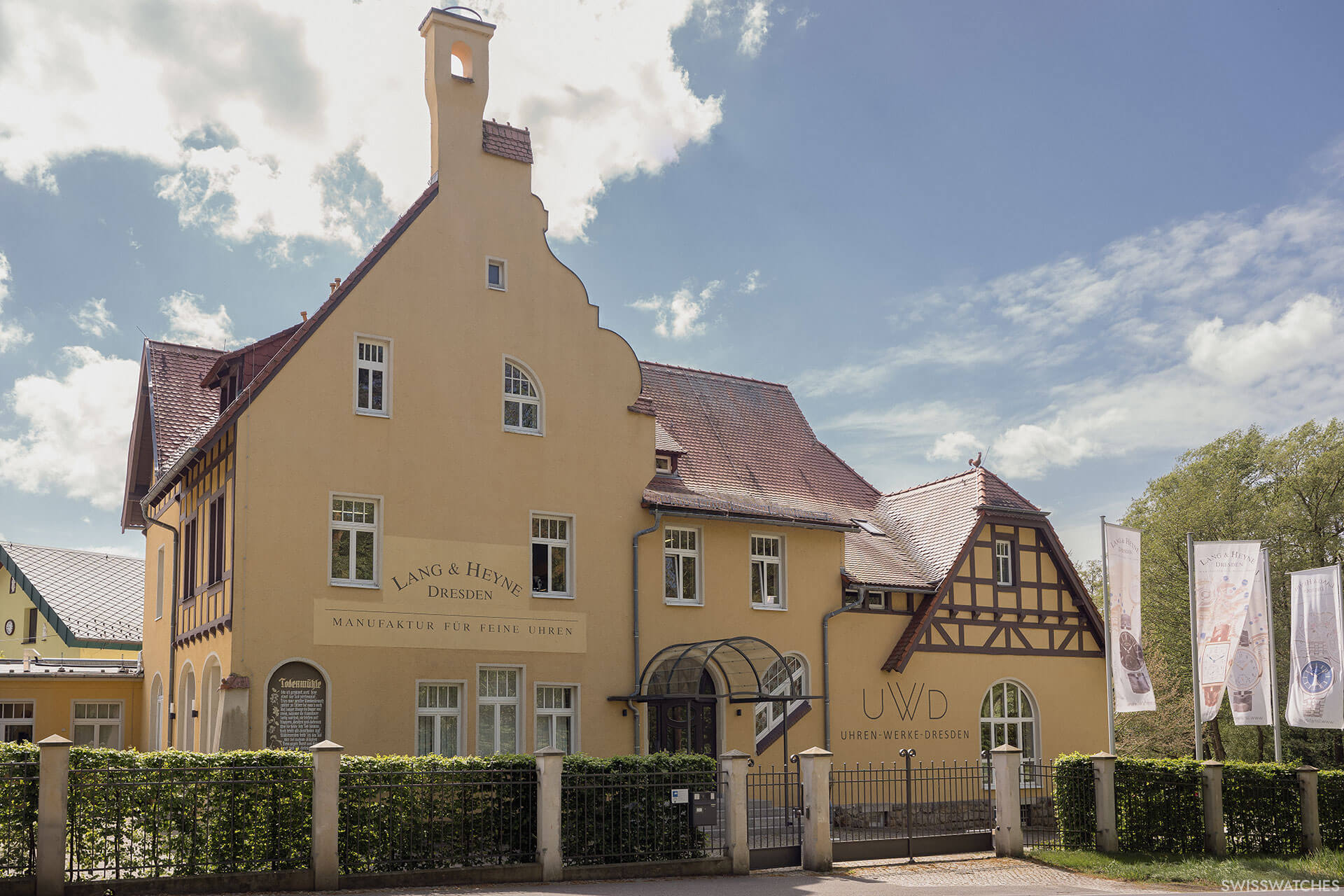
Anyone who has studied Lang & Heyne watches in detail will probably look at fine watchmaking with different eyes. Of course, there are also other brands with such a high level of vertical integration – and other brands that produce even more complex movements. But it is the combination of a high level of craftsmanship, a love of detail in the finishing of almost all components of the watch – even the parts that are not visible – a very high degree of recognisability and a price for quality that is unparalleled in the industry. But there is another speciality at Lang & Heyne: based on the core collections, the company creates highly limited special editions or even one-offs for customers, which combine the concentrated savoir-faire of the manufacture and which stand out from the regular models in terms of technology and design. We will introduce you to the most captivating creations that you should know about – and perhaps inspire you to create your own personal favourite piece that you can commission from Lang & Heyne.
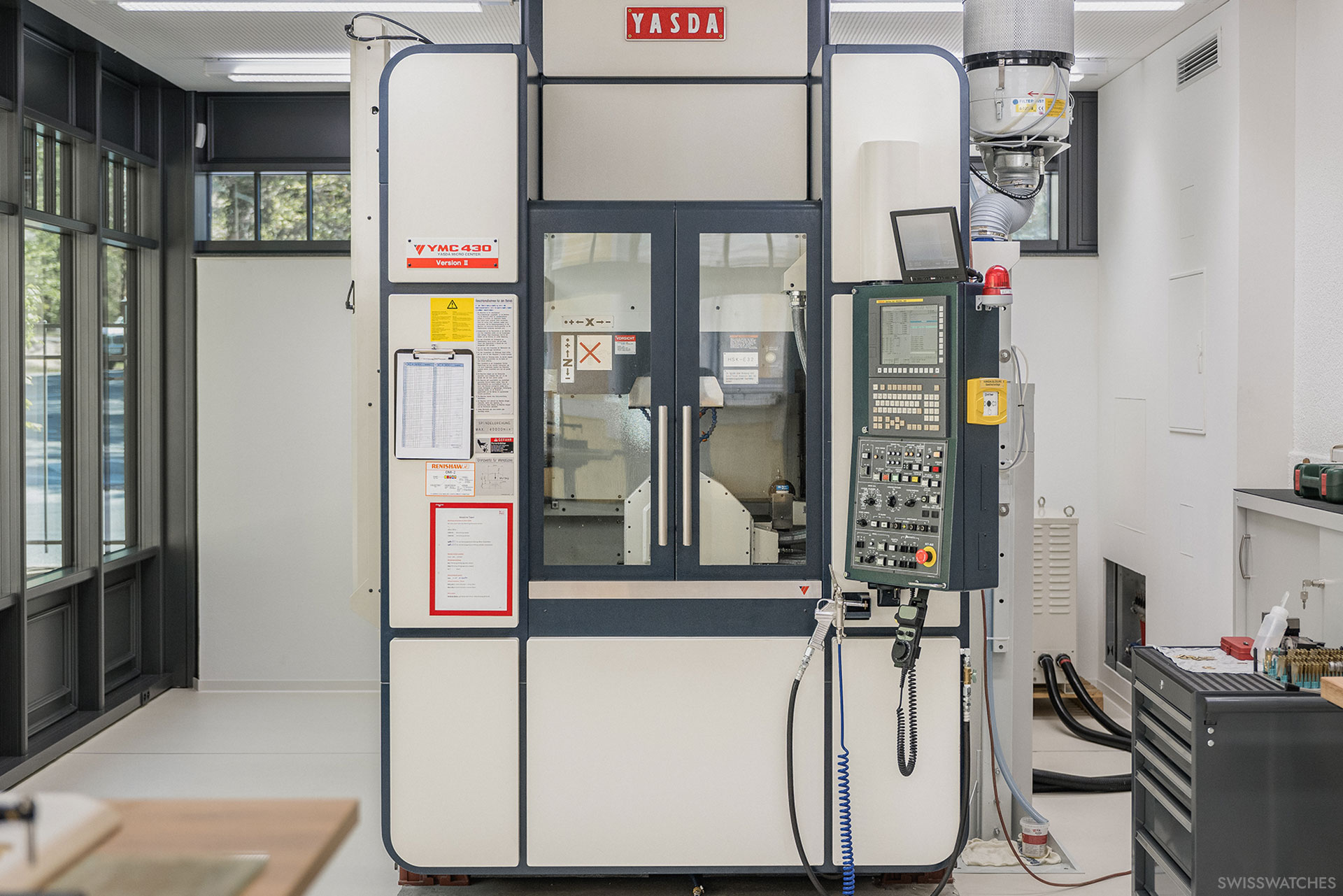
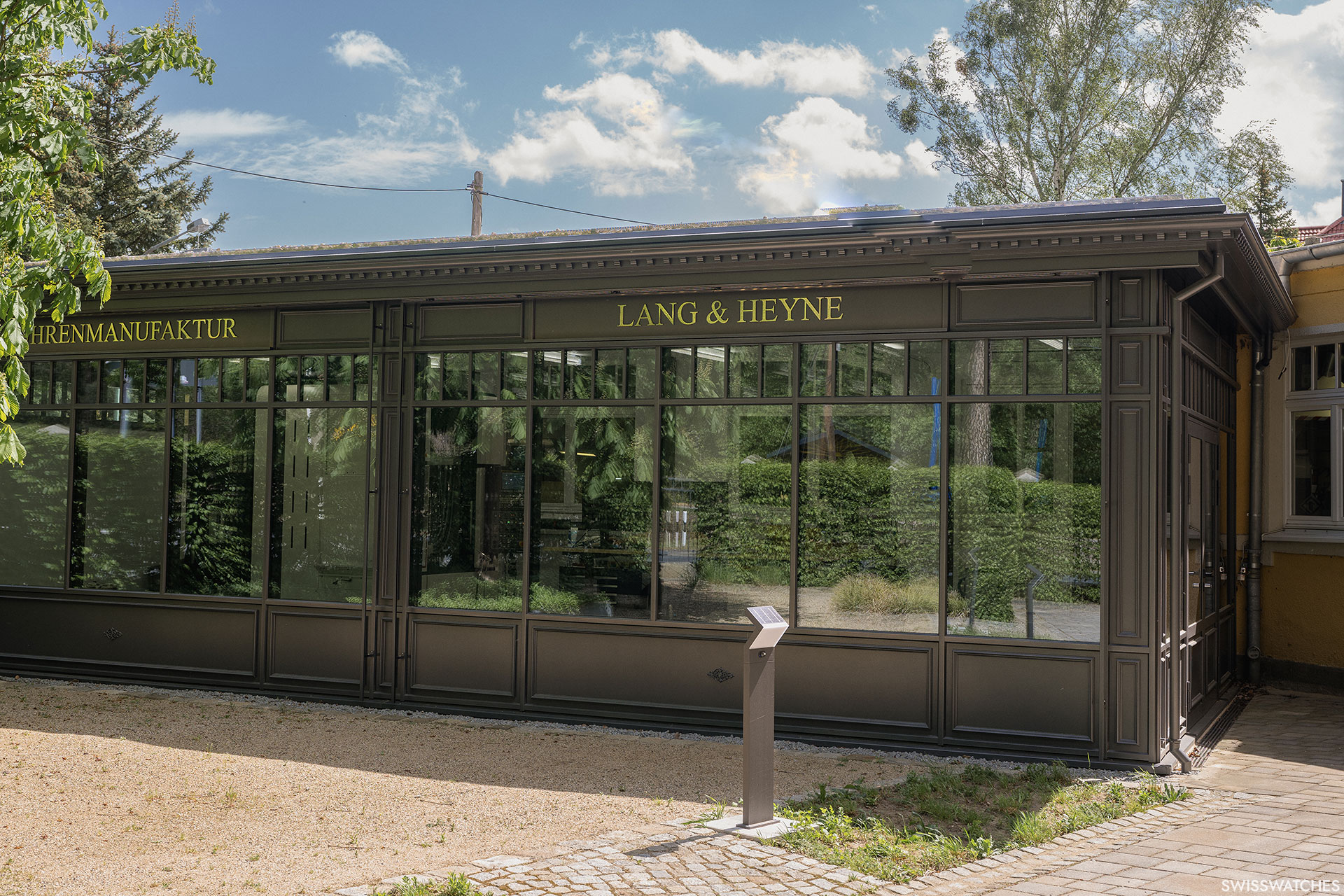
In-house dial production
The great advantage of a manufacture like Lang & Heyne with such a high level of vertical integration is that it can draw on the wide-ranging expertise available in-house for unusual gimmicks and special requests. Lang & Heyne not only manufactures over 90 percent of its movements in-house, but also enamel and ceramic dials and hands, whereby the ceramic dials come from an external supplier but are further processed, hand-painted and finished at Lang & Heyne. The enamel dials are produced exclusively in-house by a porcelain painter who, incidentally, trained at the world-renowned Meissen porcelain manufacture. This is because no air bubbles or impurities are allowed to form when filling the enamel and firing it several times. As for the champlevéenamelling technique, which is predominantly used at Lang & Heyne, fine enamel chips are set into a dial shape under a microscope. It is important that there are no gaps where bubbles could form. The dials are then fired three to four times and the surfaces are polished flat. The fine lettering is engraved by hand by a specialised engraver.
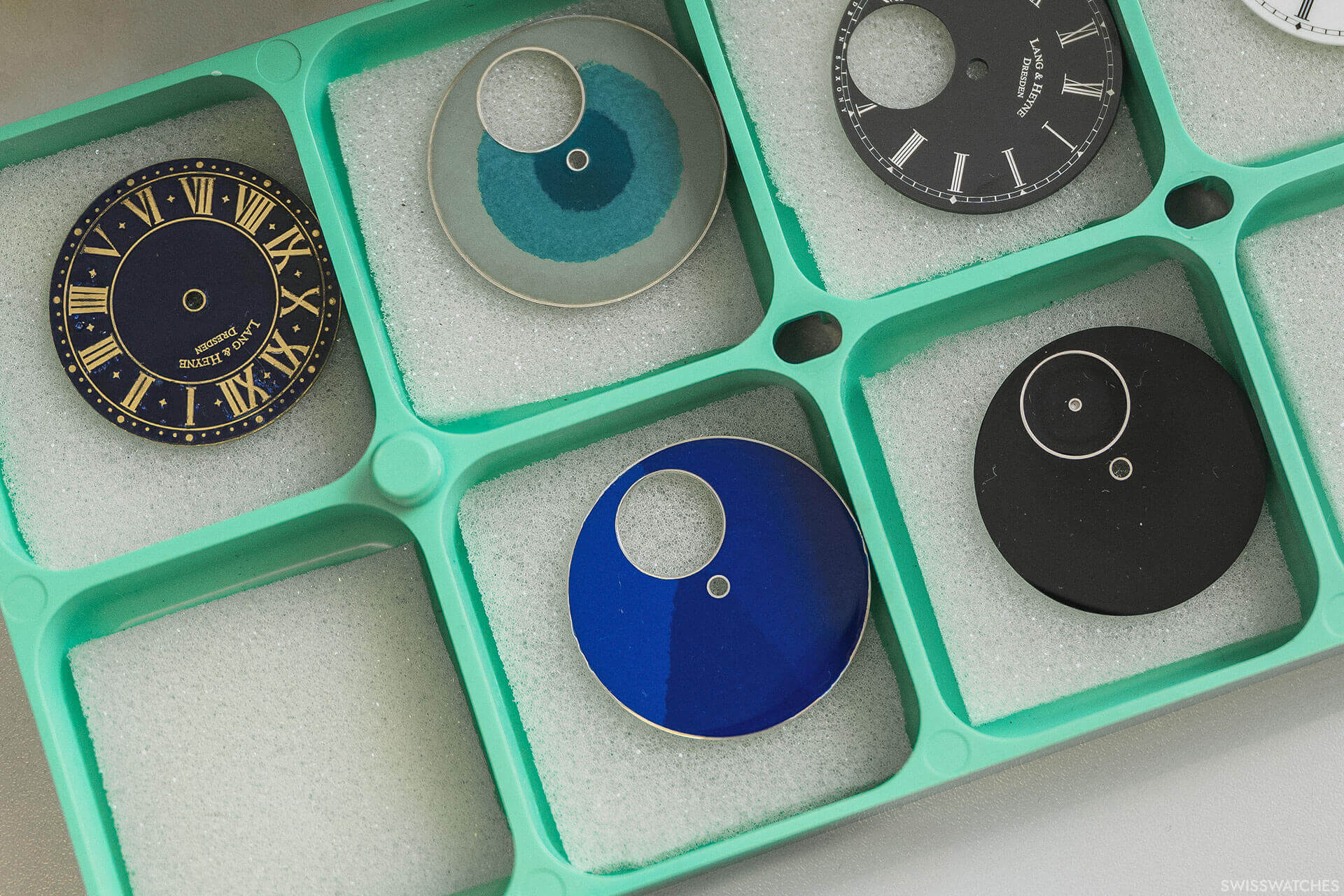
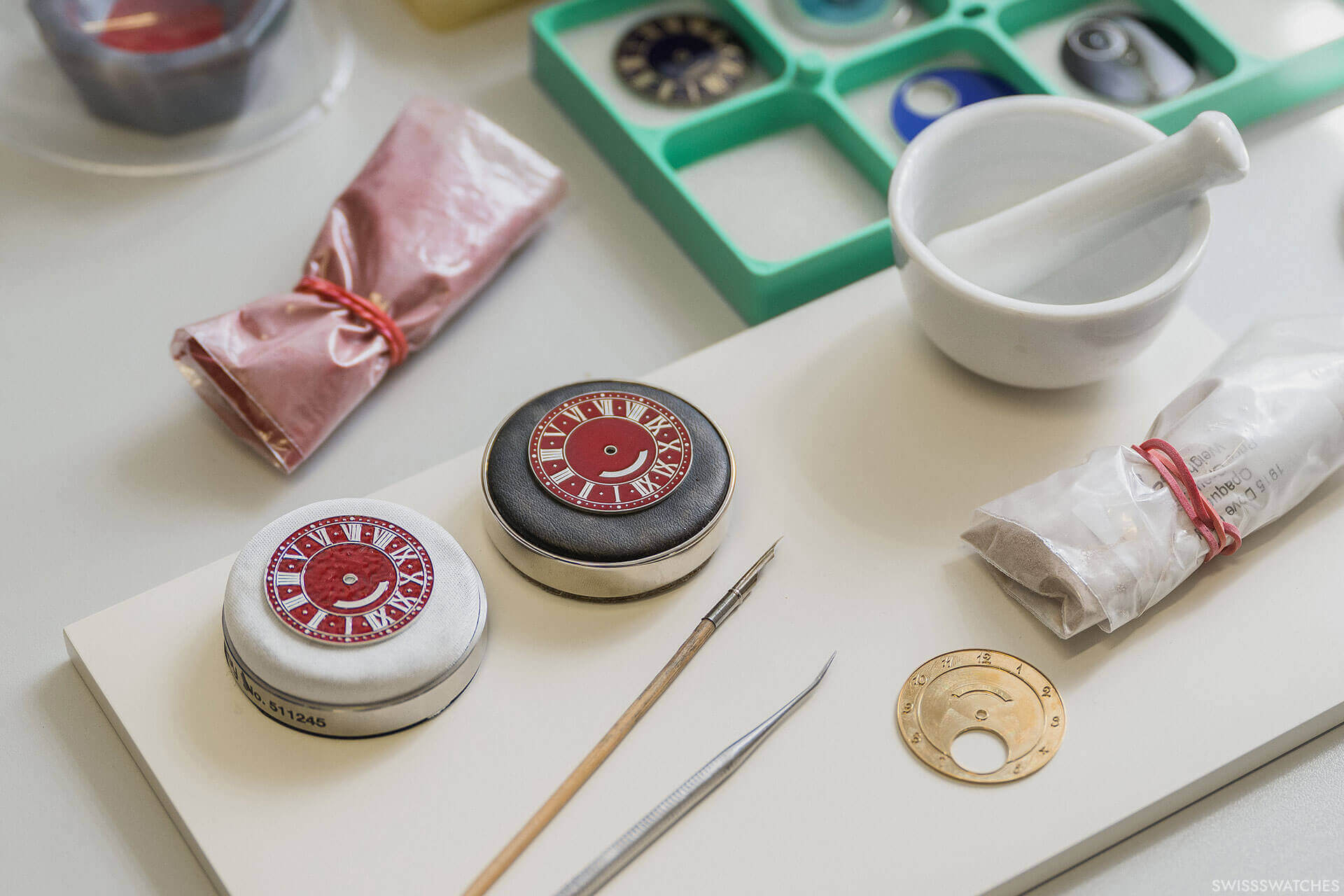
Ceramic, on the other hand, is much harder and more resistant than enamel. The raw ceramic disc blanks come from an external supplier and are engraved and cut out using a laser. Engravings for the logo or the hour markings, which are then laid out by hand at Lang & Heyne using the high-quality printing ink Berlac Print, can be realised with a line width of up to 0.05 mm. The edges are bevelled and polished, giving the dial a beautiful, three-dimensional appearance. As the ceramic is made of aluminium oxide, machining is only possible with diamond tools and pastes. The final step is to flatten the dials on a wooden disc and polish them to a high gloss.
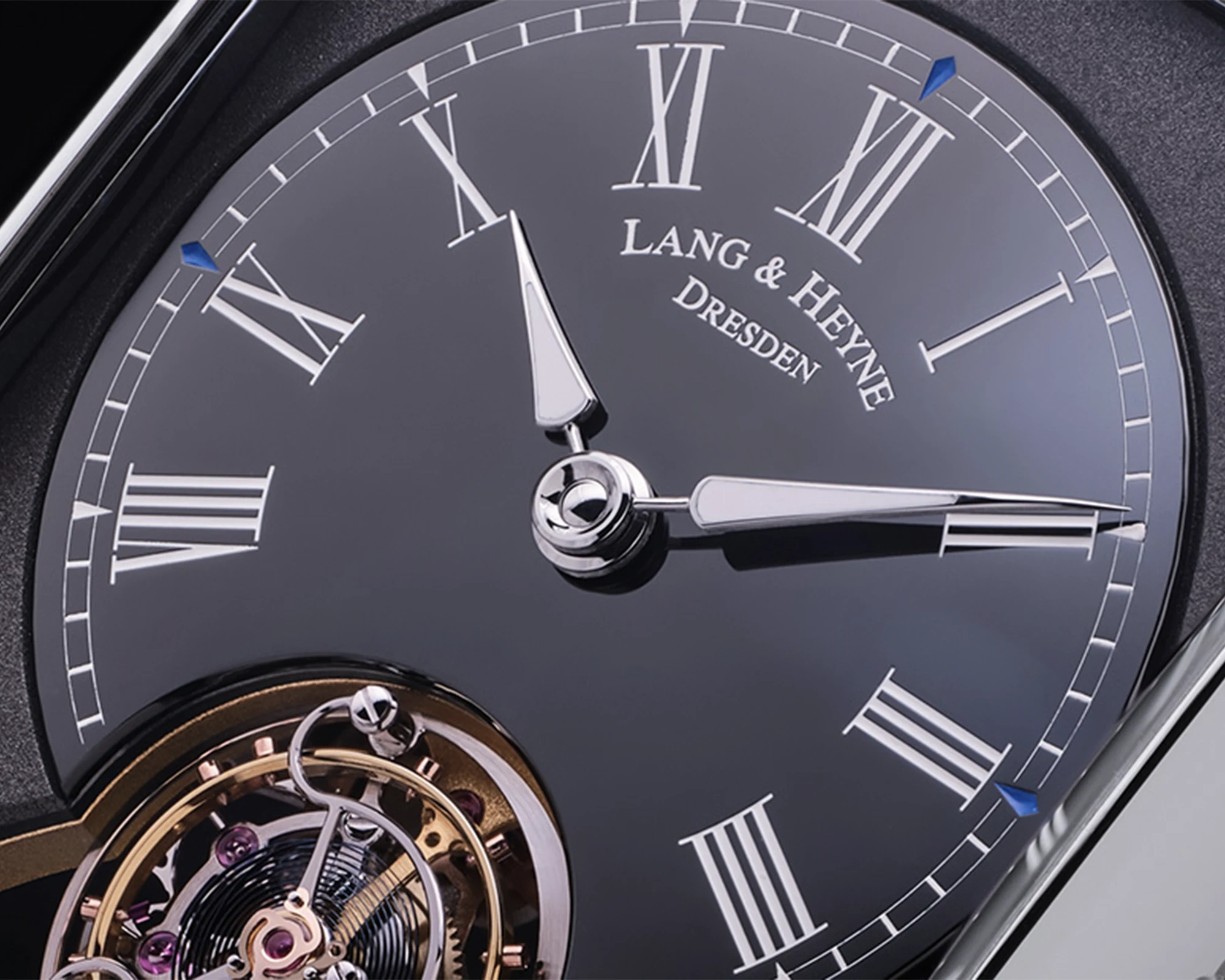
Homage to the Glashütte tower clock
To mark the revision of the movement of the church tower clock of the Protestant town church of St Wolfgang in Glashütte in 2019, for which Lang & Heyne covered the costs of refurbishing the movement, the watchmakers presented a wristwatch limited to five pieces. The special feature of this piece was not only the blue champlevé dial, which was inspired by the colour and unique architecture of the dial design of the church clock, but also the gold hands crafted in-house by hand, which display a sun on the hour hand and a moon on the minute hand. More on this in a moment, but first, a few words about the dial. In the champlevé technique, the prefabricated ‘pockets’ are filled with coloured enamel and fired. As already mentioned, it is important that there are no gaps where bubbles could form.
In-house hand production
Back to the hands, which are manufactured in-house at Lang & Heyne. Anyone who has ever admired the hands of a Lang & Heyne watch will have recognised that they have a three-dimensional shape. Several steps are necessary to achieve this. The hand blanks are first laser engraved and then subjected to a peripheral grinding process, during which rough edges are removed. In the next step, a degussite grinding stone (a ceramic composition) is used to carve recesses and contours into the hand, creating sharp and defined transitions and edges. The hand is then brought into its three-dimensional shape with a finer sandpaper and polished until it achieves a high lustre. Finally, the hand is treated with a paste for the final polish.
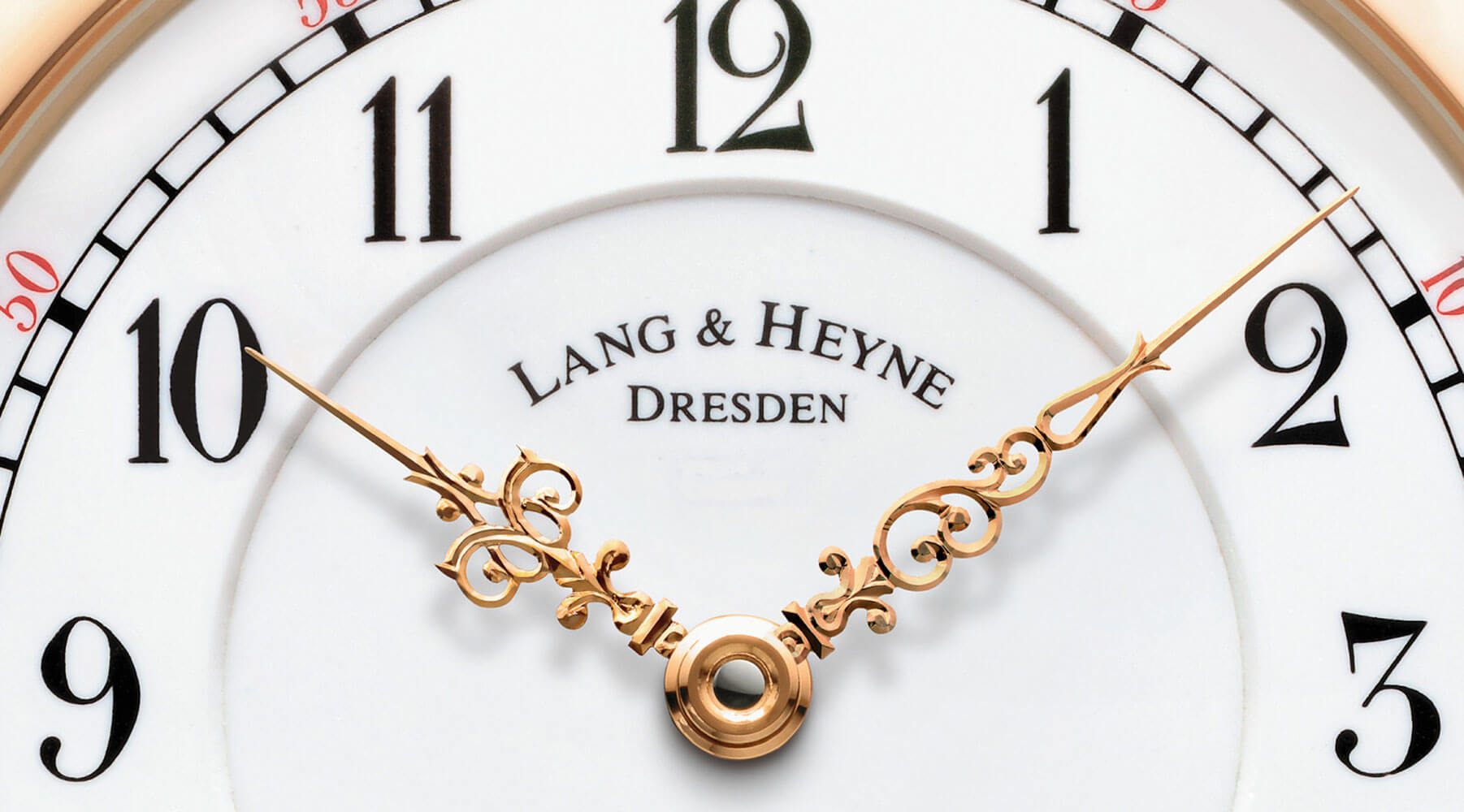
Hands that are to be given a blue surface are heated over a flame until the desired colour nuance is achieved. Lang & Heyne uses a variety of hand shapes, from cathedral hands and pear-shaped hands to elaborate Louis XV hands or modern lancet hands, which the customer can choose individually. Very special types of hands are also created for special editions such as the Hommage tower clock or customised pieces.

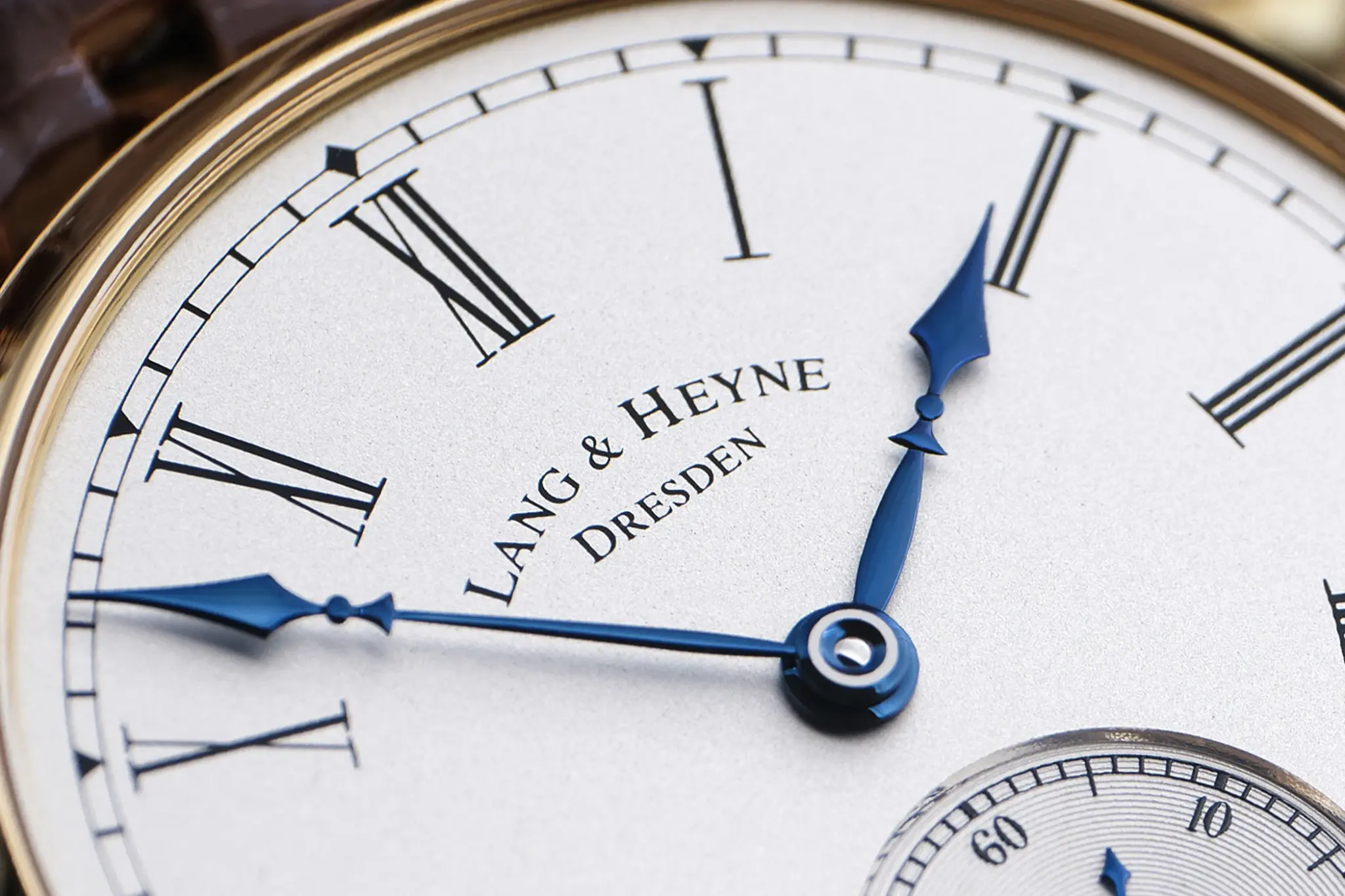
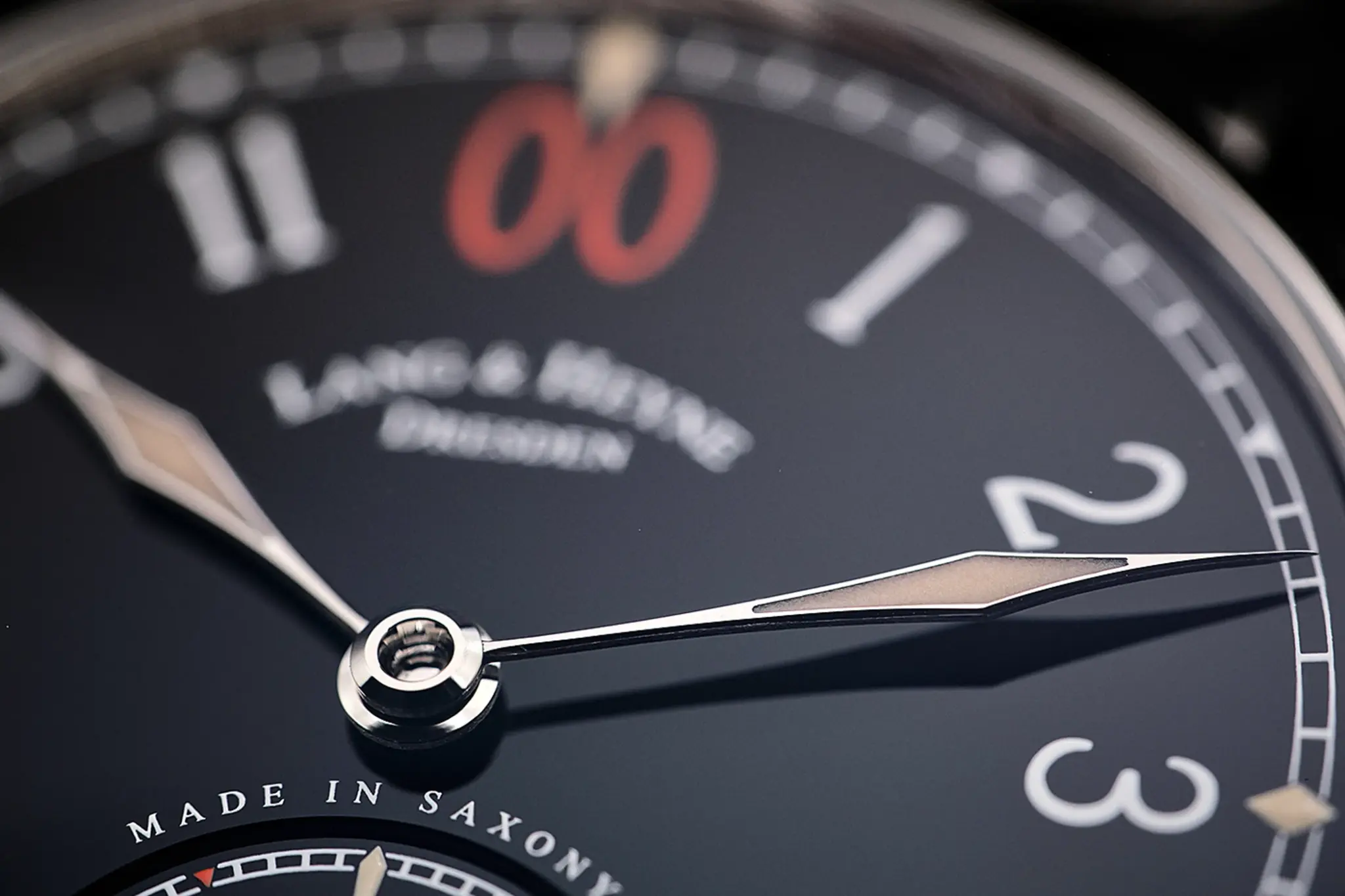
Georg SHH Edition I (Sincere Fine Watches)
2022 marked the start of the highly limited special editions in collaboration with the luxury watch retailer Sincere Fine Watches, which distributes Lang & Heyne watches in Southeast Asia. The Georg Sincere Haute Horlogerie Edition was limited to just 12 pieces in 2022 and 2023 and was available exclusively through Sincere in Singapore, Kuala Lumpur and Bangkok.
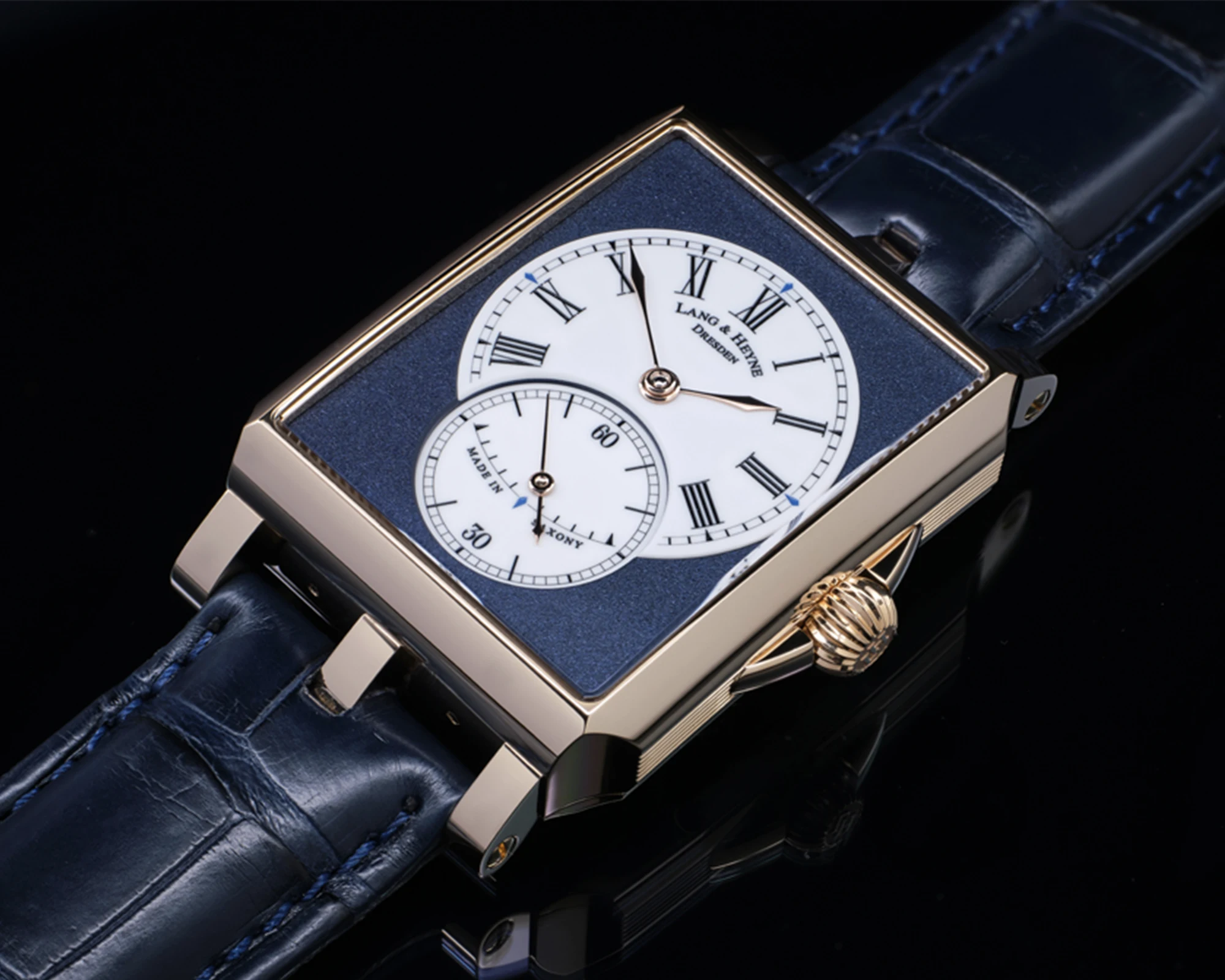
For the first time, Lang & Heyne combined a ceramic dial on a royal blue or burgundy galvanised baseplate with a givree finish, a technique in which the surface is slightly roughened (sandblasted) and forms a beautiful contrast to the mirror-flat surface of the ceramic.
The Calibre VIII manufacture movement, which is also used in the regular Georg edition, shows off carefully finished gold wheels, levers and springs as well as the slightly curved stainless-steel bridges and cocks through the open sapphire crystal caseback.
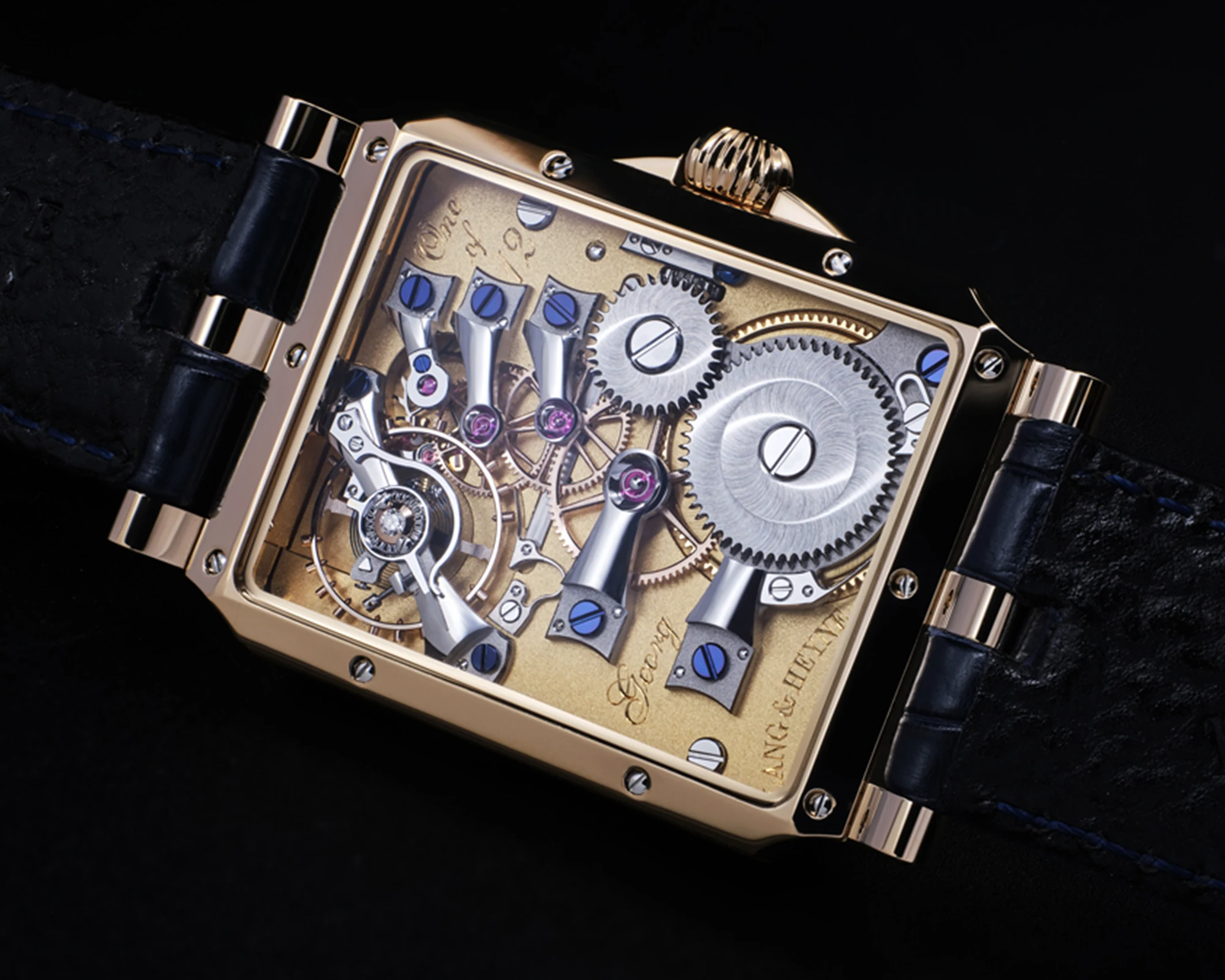
A titanium movement – Frederick II Remontoir ‘The Lavish Attic’ Edition
At the end of 2022, the company then launched another real highlight with three technical innovations. For the Friedrich II Remontoir ‘The Lavish Attic’ Edition, which is limited to nine pieces and pays homage to its long-standing partner ‘The Lavish Attic’ from Hong Kong, Lang & Heyne used a titanium movement for the first time, the first black enamel dial, and the first remontoir with an off-centre second hand. The dial consists of two enamel discs – one for the main dial and another for the small seconds at 6 o’clock, which are fixed to a metal support and printed with lacquer.
We know titanium primarily from watch cases. But a titanium movement – and for such a classic brand as Lang & Heyne? On the one hand, titanium technically offers greater strength and corrosion resistance, which has a positive effect on the movement, but due to its robust nature, the material can only be machined with hard material tools. In the Friedrich II Remontoir ‘The Lavish Attic’ Edition, the movement plate, wheel bridge, pallet lever bridge and balance cock are made from medium-hard grade 2 titanium. The surface is sandblasted with ceramic beads for a matt finish. The chamfers are then polished using wood as a carrier and polishing paste. However, line cuts and hand engraving are no problem with titanium. The next challenge is that the bearings of the parts had to be redesigned due to the poor friction behaviour. The solution: the barrel and winding stem are bedded in separate bronze bearings.
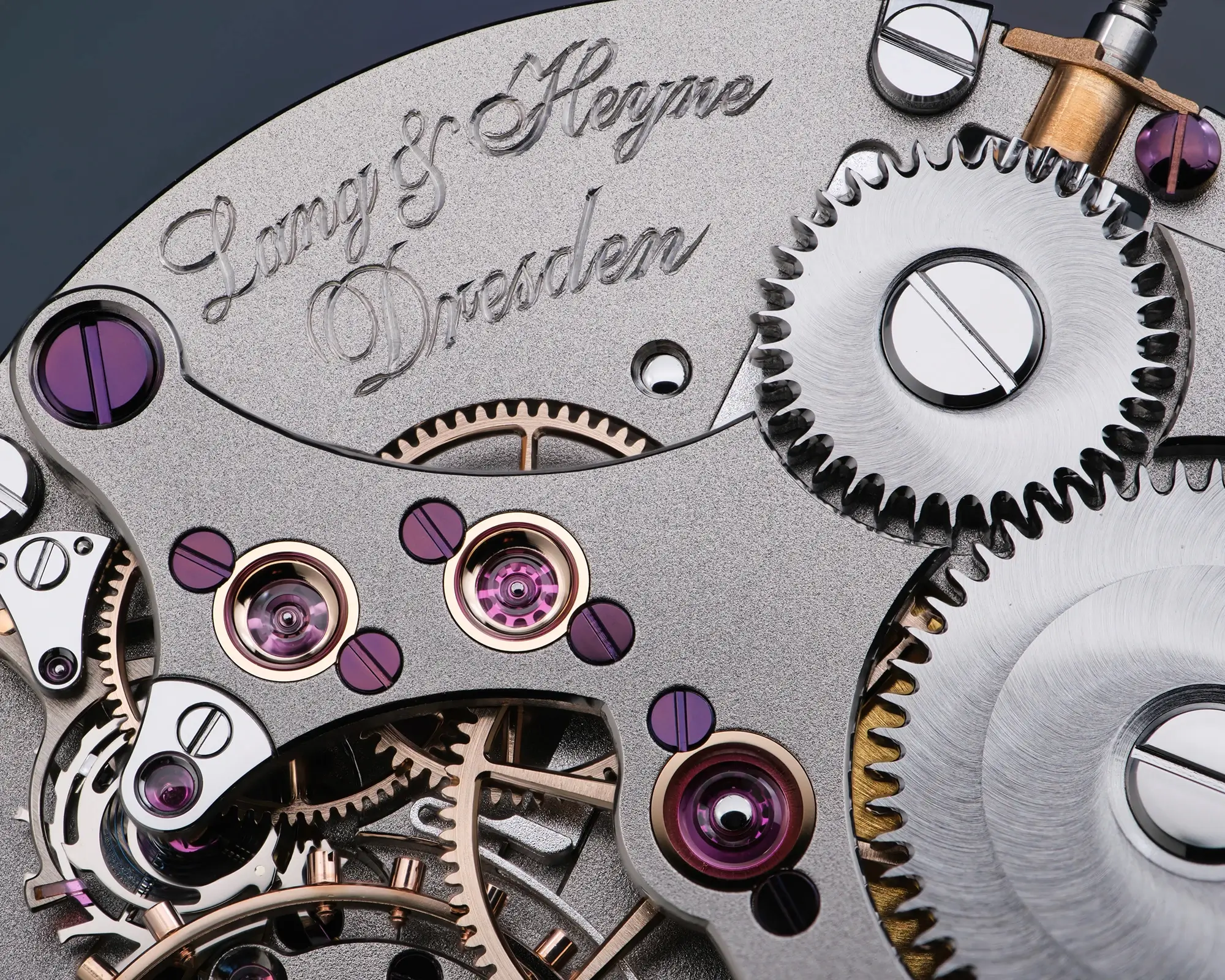
The Remontoir
With a new Calibre VI-I, the Friedrich II Remontoir ‘The Lavish Attic Edition’ marked the first time that Lang & Heyne used the remontoir, which improves the accuracy of the watch. The Calibre VI-I added a small complication to the Calibre VI, the so-called remontoir, which means ‘winding’. This mechanism consists of a hairspring that is integrated into the movement of the watch together with a control mechanism. To understand how it works, you have to imagine that this hairspring, which is located on the escapement wheel and drives it alone, supplies the balance wheel with power and maintains its oscillation. The rest of the gear train is stopped by a locking lever and stands still. As the escapement wheel rotates, it moves this lever until it releases the ratchet. The gear train, which is under the force of the mainspring, can now rotate (very quickly), move the hands and tension the power spiral until the opposite claw of the locking lever stops the process again. This process has two advantages. While the force of the mainspring gradually decreases as the watch runs, the hairspring supplies the balance with a relatively constant amount of energy. However, this only works as long as the energy of the mainspring is sufficient to fully re-tension the hairspring. Secondly, this mechanism can be used to realise jumping displays, in this case a jumping second.
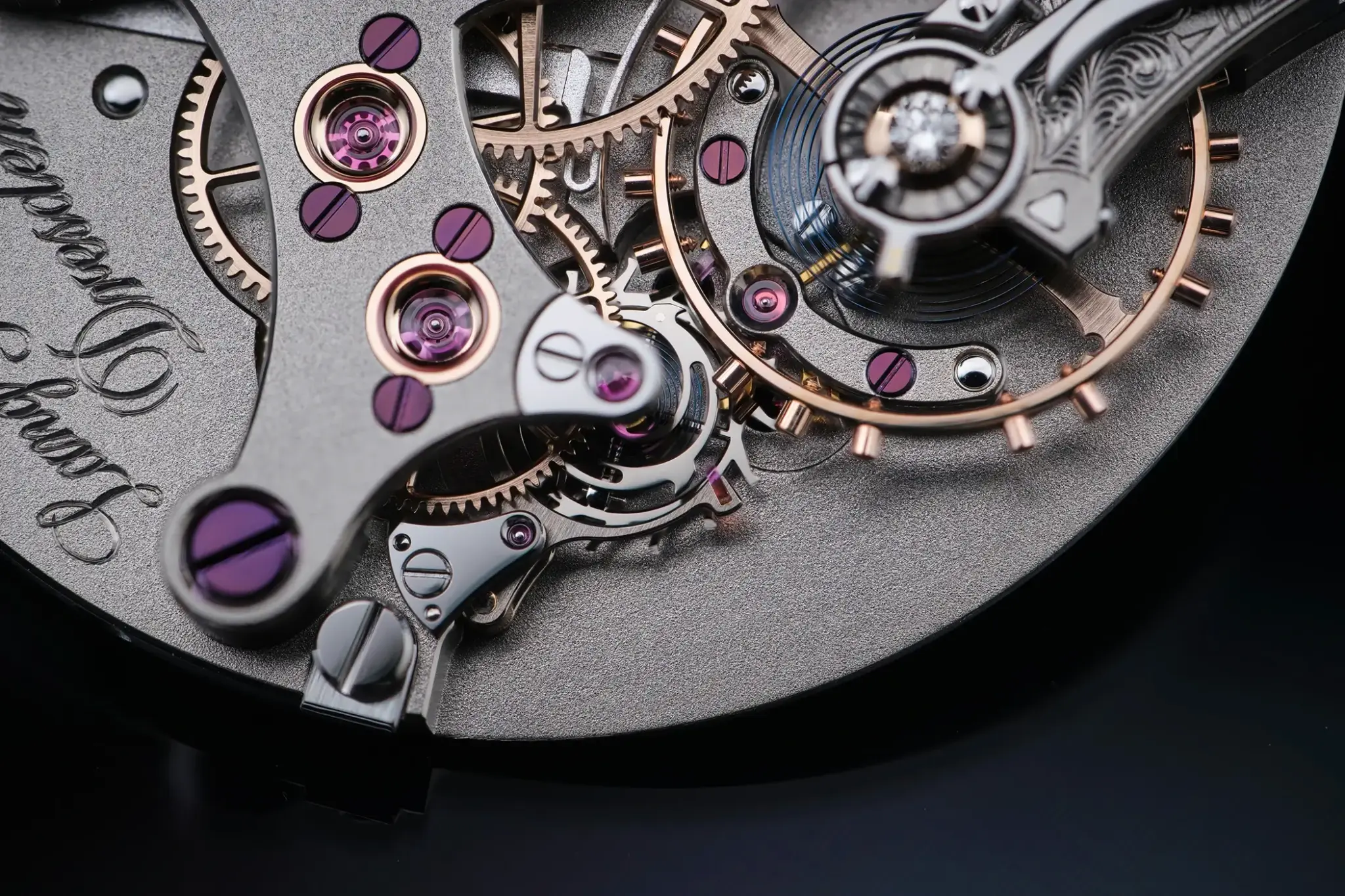
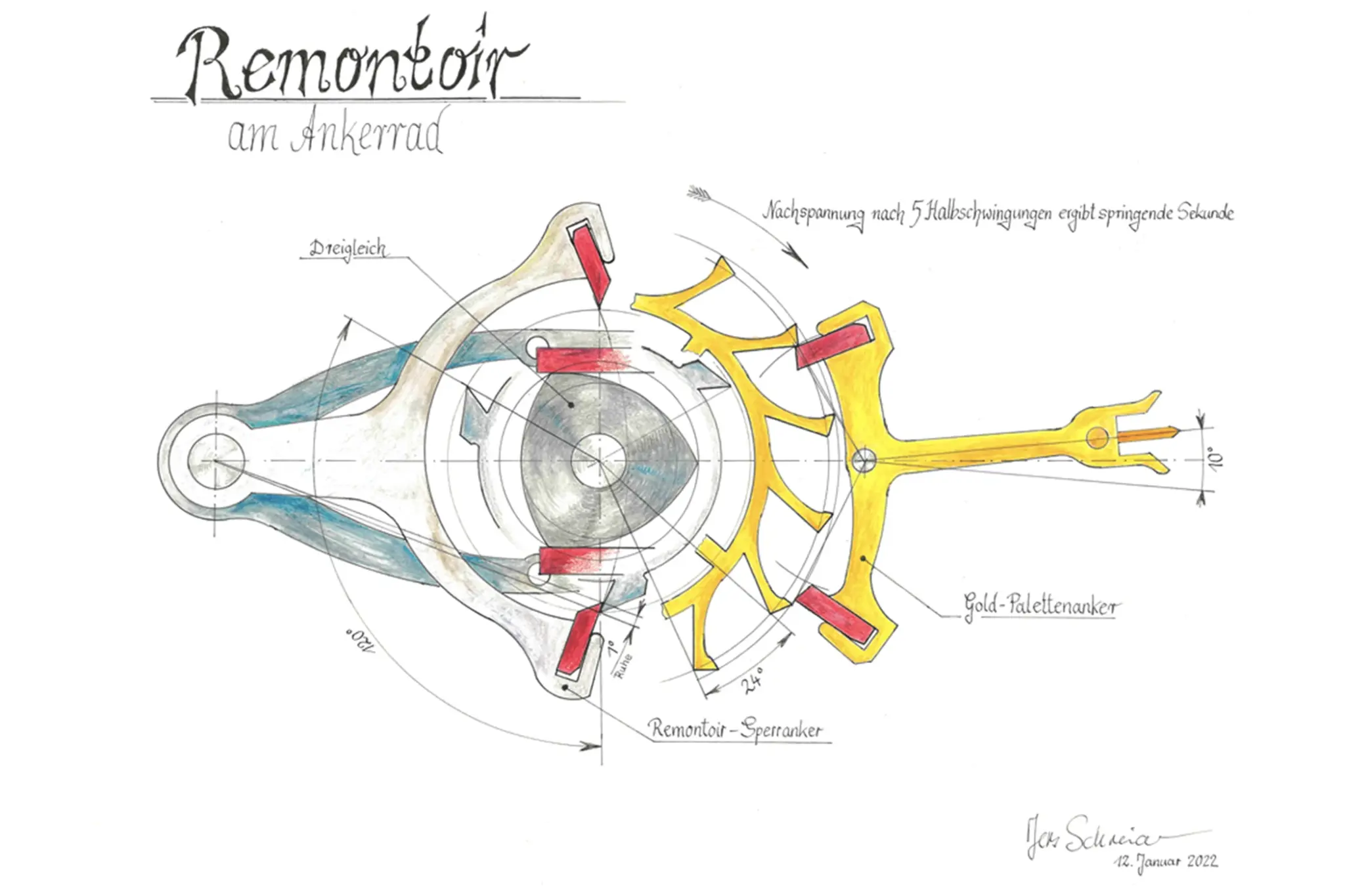
Anton Manufaktur Edition
The Anton Manufaktur Edition was presented last year as another exciting special edition that combines all the technical and handcrafted specialities and developments of recent years. The edition comprised five timepieces. The dial is made of black ceramic on a dark grey, givre-finished base plate with pike hands. The special feature of this watch is undoubtedly the open design of the baseplate, which gives the flying tourbillon a new perspective and makes it stand out even more. The rehaut, which acts like a mirror, provides an even better view of the complication. In addition, the wonderful architecture of the Calibre IX-I reveals the function and mechanics of the movement in a way that is both simple and captivating.
Lang & Heyne has made a few modifications to the flying tourbillon of the Manufaktur Edition, which is based on the design by Alfred Helwig. The anchor now consists of two bodies and enables more precise adjustment. The redesigned shock protection spring is easier to fit and thus minimises the risk of damage.
HyCeram (instead of luminous material)
The so-called pike hands are made of ceramic and filled with HyCeram, an innovative material that has a very practical use. Polished hands are often difficult to read on dark dials, which is why Lang & Heyne uses this highly developed ceramic material, which is known for its high light reflection and good durability. The ceramic mass is inserted into the hand blanks and fired at a temperature of around 120 degrees Celsius for one hour. No bubbles should form during this process either. After firing, the hands are polished flat.
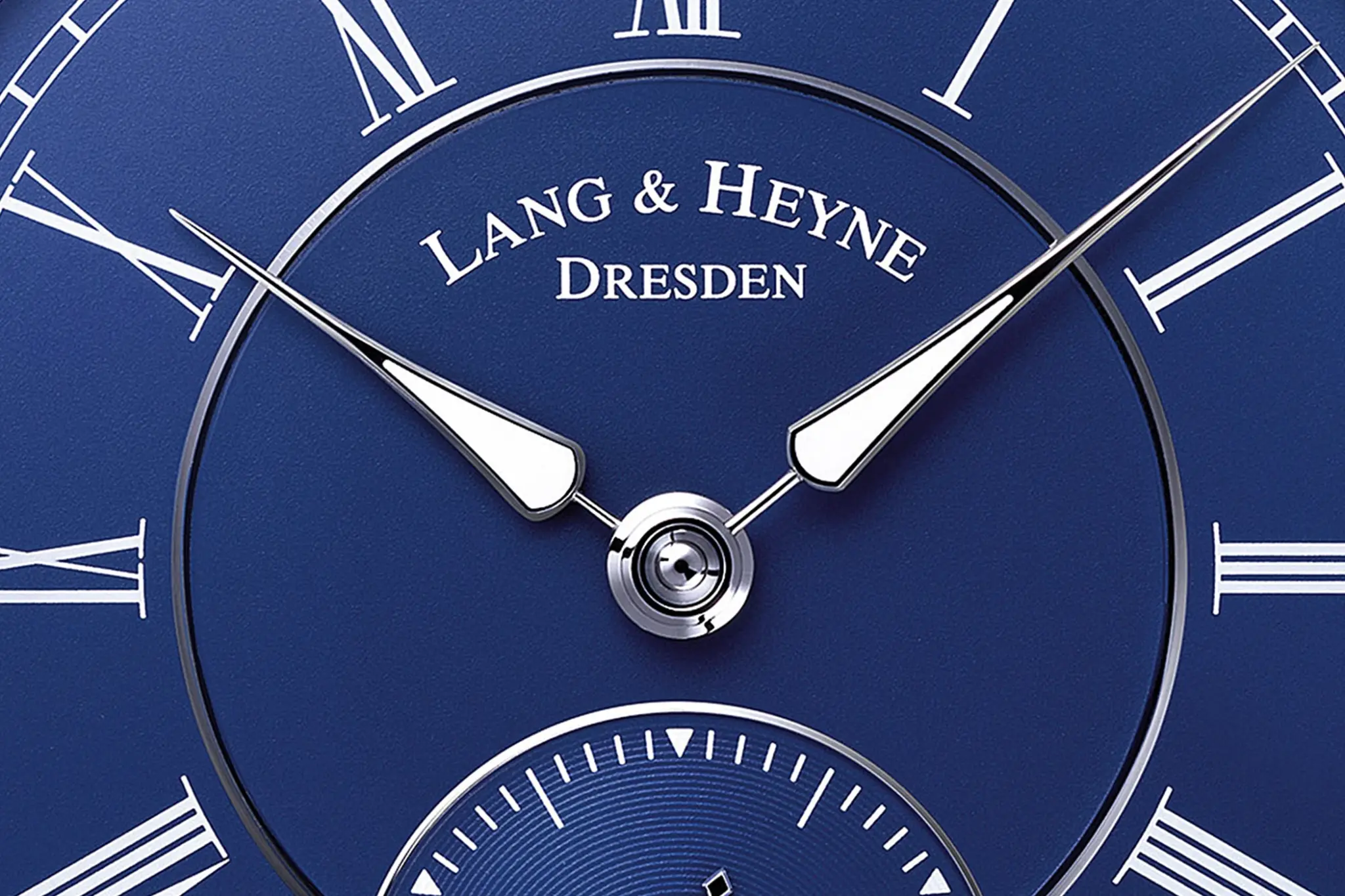

Even though Lang & Heyne follows a very classic horological approach, this does not mean that innovative techniques and materials cannot be used as long as they correspond to the values of the brand. A luminous material would certainly not fit in with the external appearance of Lang & Heyne watches – but the use of HyCeram is certainly a very successful symbiosis between traditional craftsmanship (the pike or lancet hands) and traditional materials interpreted in a modern way – because it is ultimately a specific form of ceramic, and not a super-innovative composite material from the laboratory, which would be rather out of place here.
Frederick III – Orient
For this custom-made Friedrich III, the customer requested a ceramic dial inspired by an antique Asian ceramic bowl on display at the Musée Guimet in Paris. Lang & Heyne’s porcelain painter created this beautiful enamel dial on a white-gold baseplate with blue grasses and flowers. The lettering of the logo and ‘Made in Saxony’ are not simply printed on, but hand-engraved using the champlevé technique. The delicate blued steel hands were specially designed for this piece. The 18-carat white gold case is set with a blue sapphire in the crown.
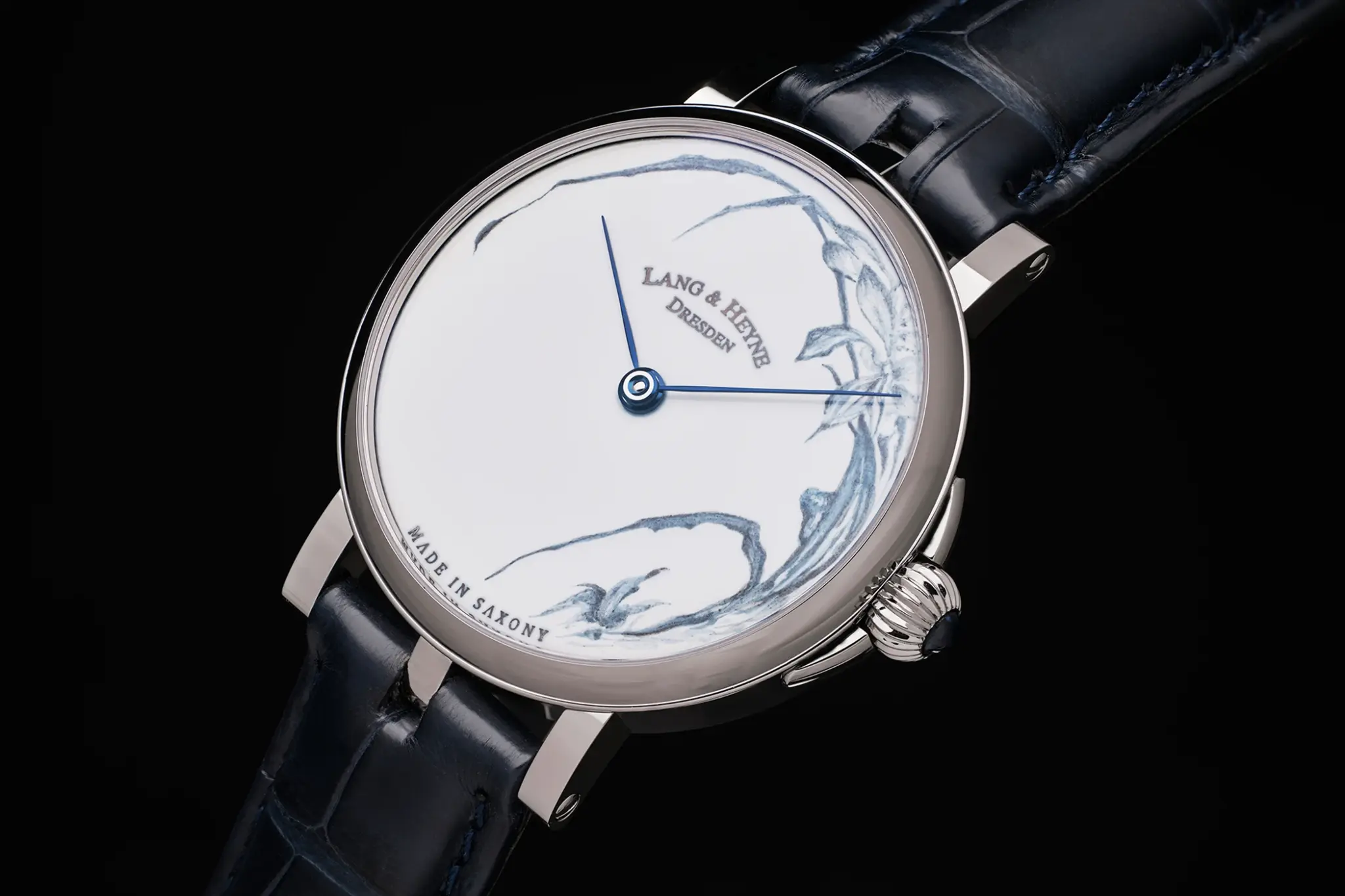
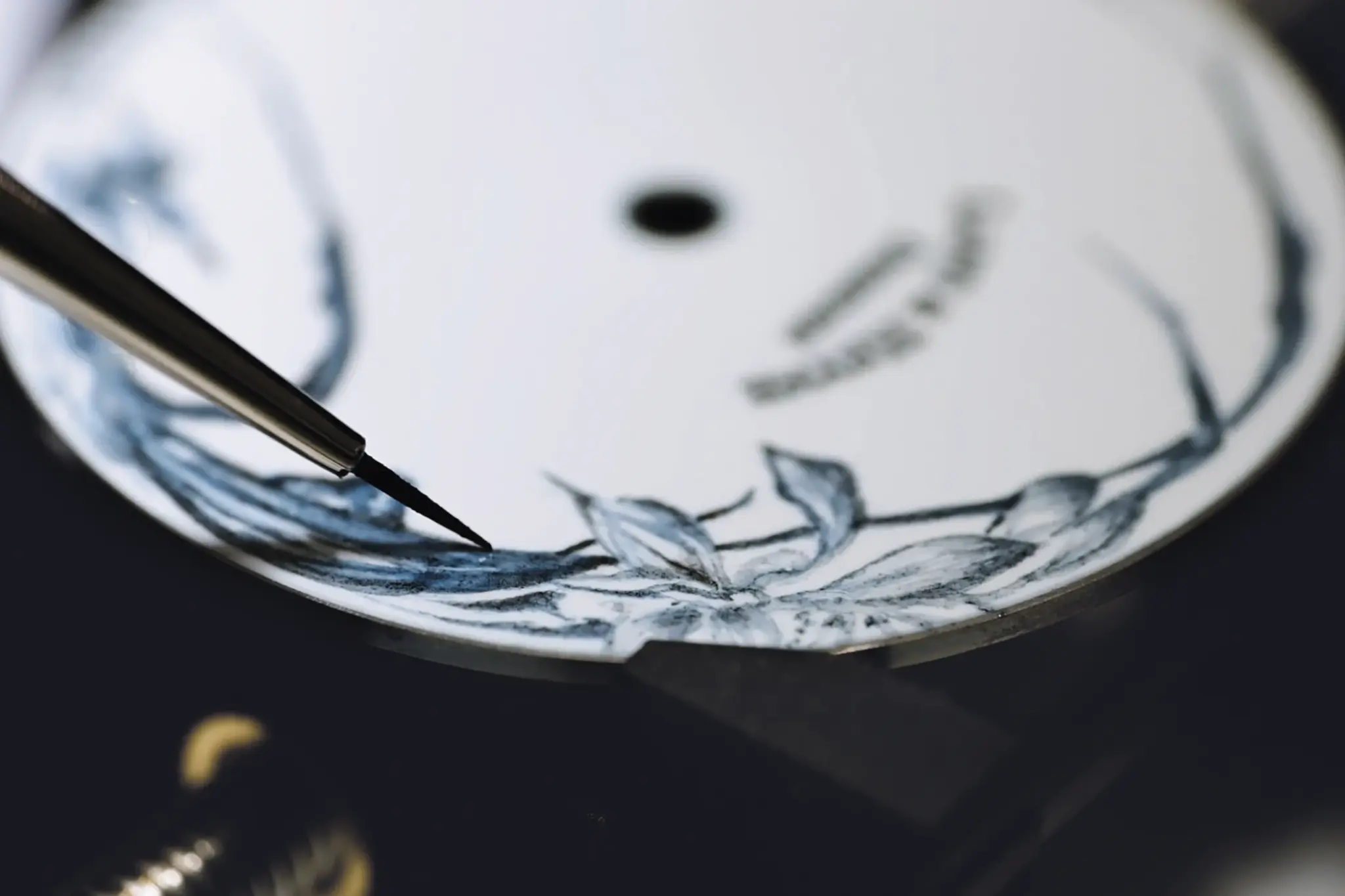
The movement also demonstrates the attention to detail with which the craftsmen at Lang & Heyne work. To compliment the dial, the movement is rhodium-plated rather than gold-plated. The red ruby bearings were replaced with transparent ones and the surfaces of the three gold wheels and winding wheels were polished.
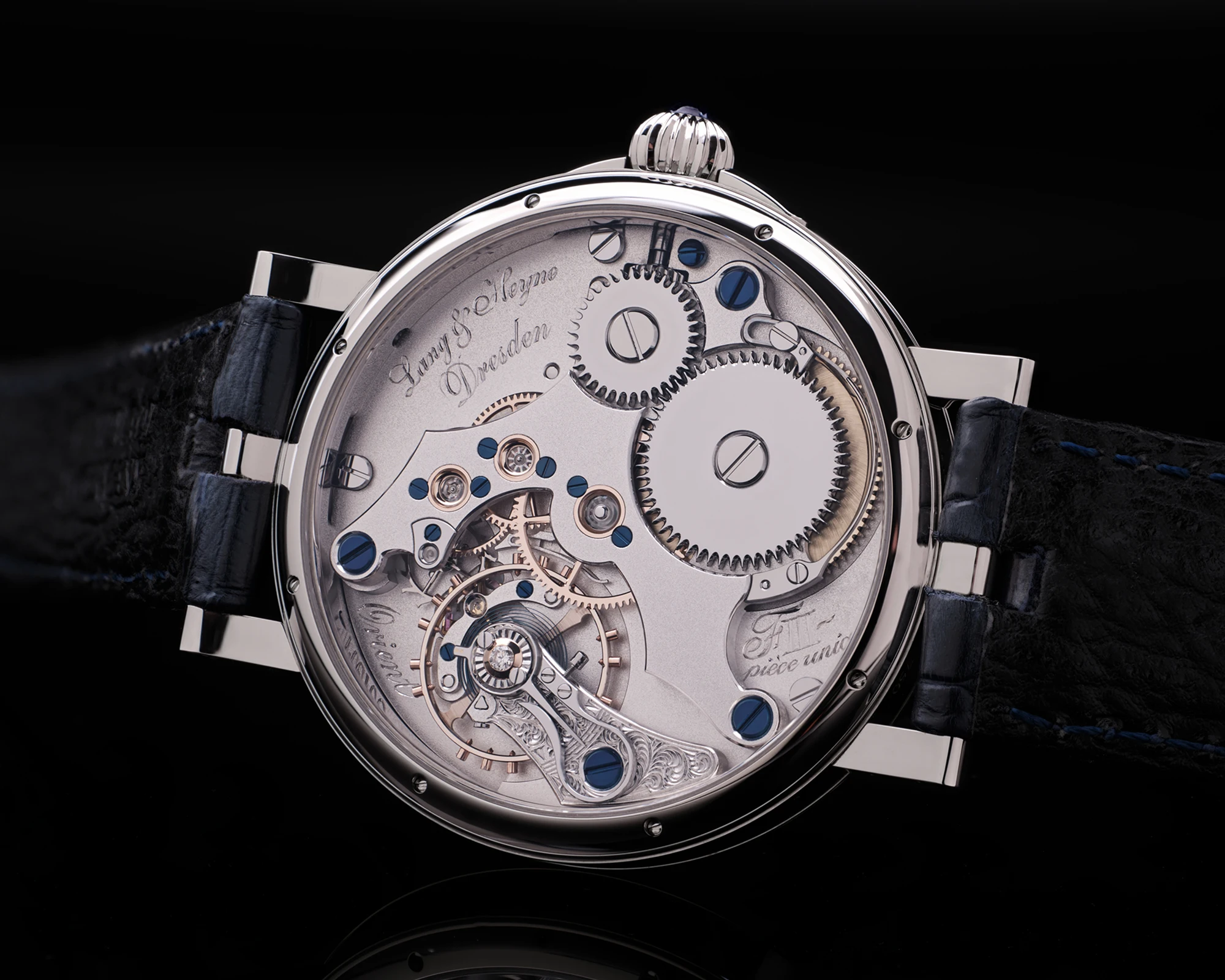
Friedrich III Terra
In 2024, a customer then commissioned a Friedrich III with an enamel dial featuring three different shades of jade green, the enamel glass of which was created using the champlevé technique. A matching green jade cabochon was set into the winding crown. The rose-gold cathedral hands are crafted by hand, too.
The Lang & Heyne Calibre VI was slightly modified for this unique piece and features transparent green jewels, hand-polished winding wheels, gold wheels and black-polished screws – the supreme discipline of polishing, in which even the tiniest scratches are polished until they have disappeared and the light can no longer refract. There is no manual for this craft – everything is based on years of experience and practice.
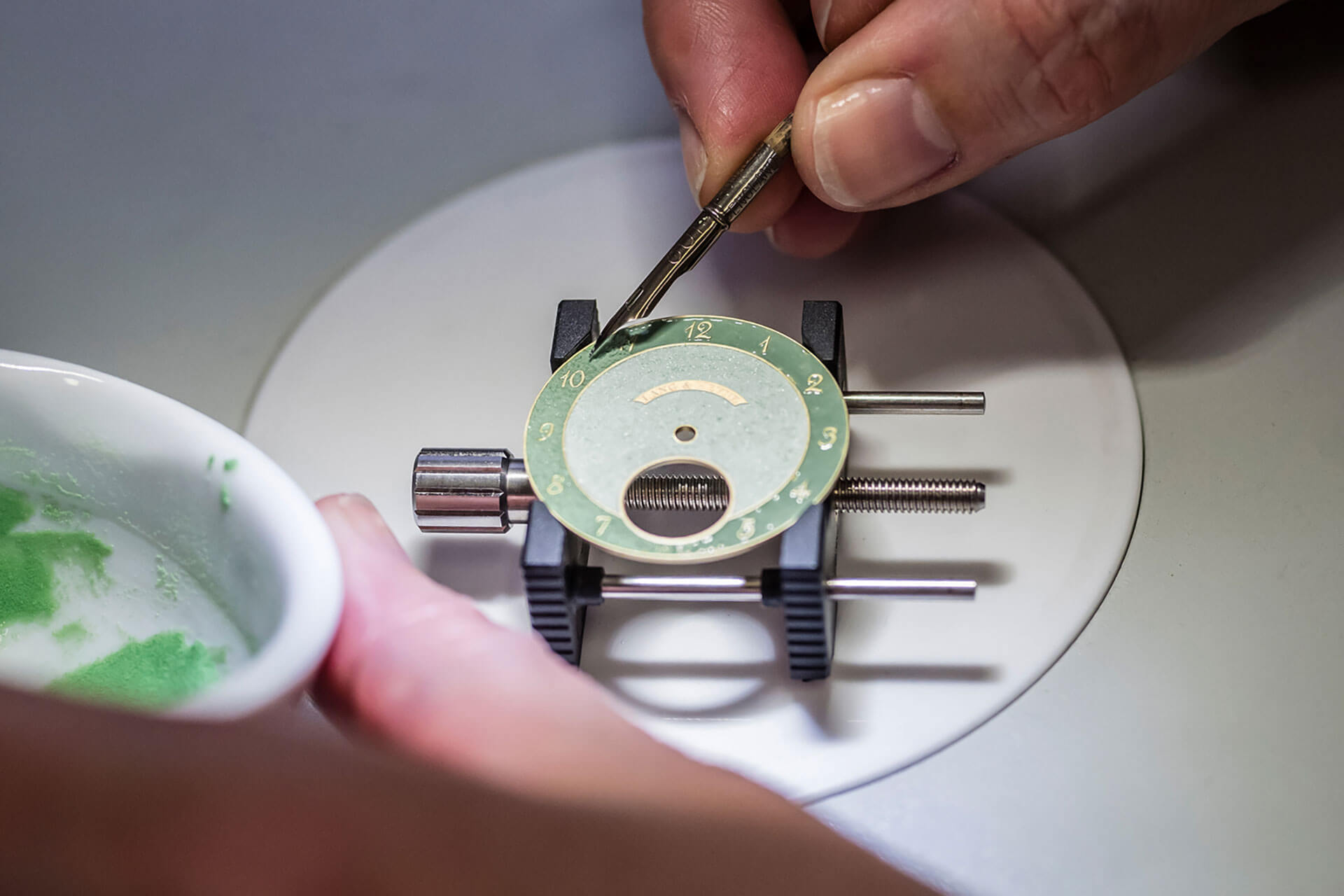
Friedrich III Remontoir Sincere Platinum Jubilee Edition
This year, Lang & Heyne presented the third edition in collaboration with Sincere Fine Watches to mark their 70th anniversary – and it is also my personal favourite piece from this special series. It has a beautiful white ceramic dial with a royal blue decorative plate in the centre, which has the same roughened (sandblasted) texture as the previous models in the Georg line. The seconds display forms a further level and gives the dial a three-dimensional appearance, which is certainly enhanced by the bevelled and polished edges. The Roman numerals have been carefully engraved into the ceramic and then filled with black lacquer. The Sincere Fine Watches logo is engraved onto the sapphire crystal.
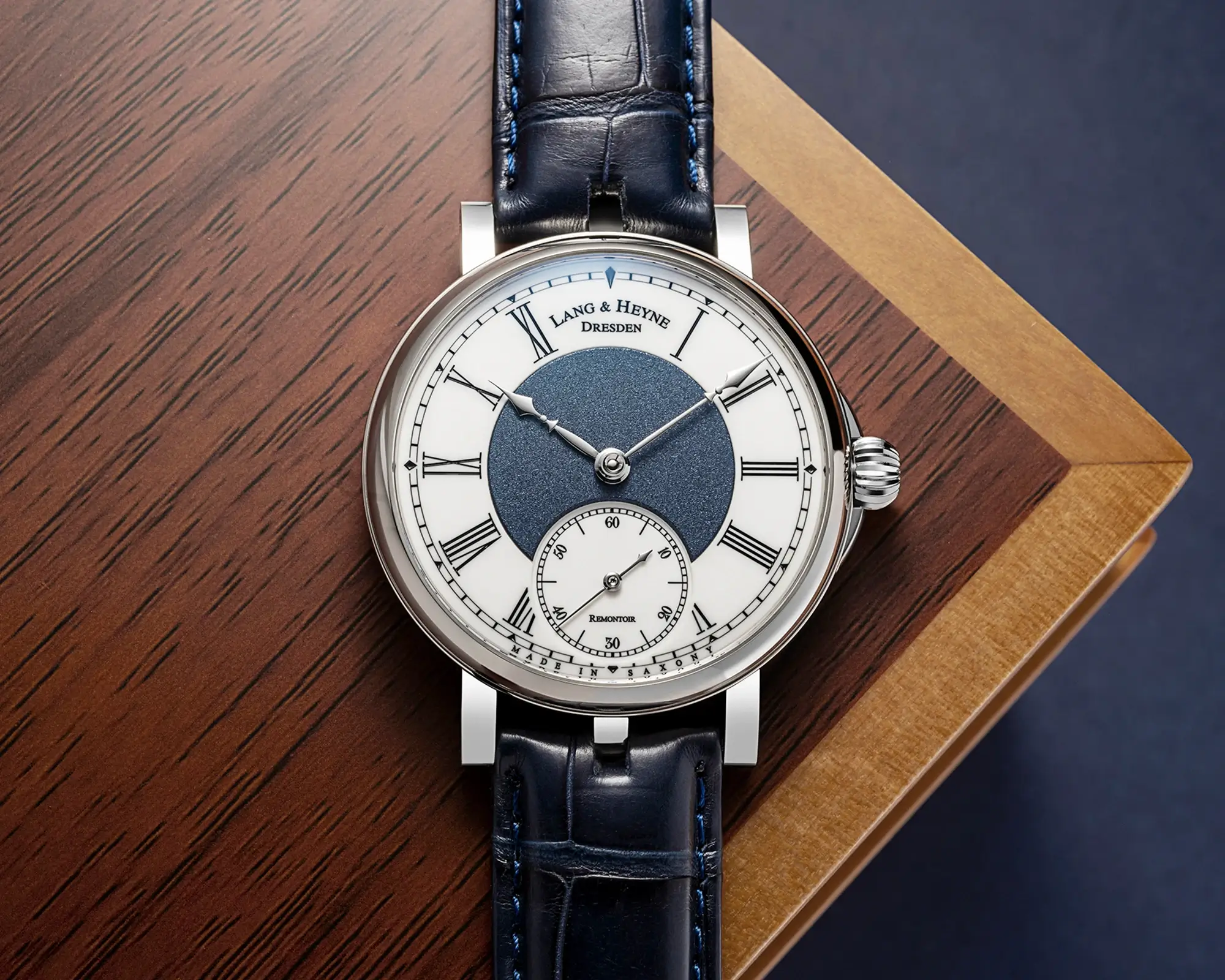
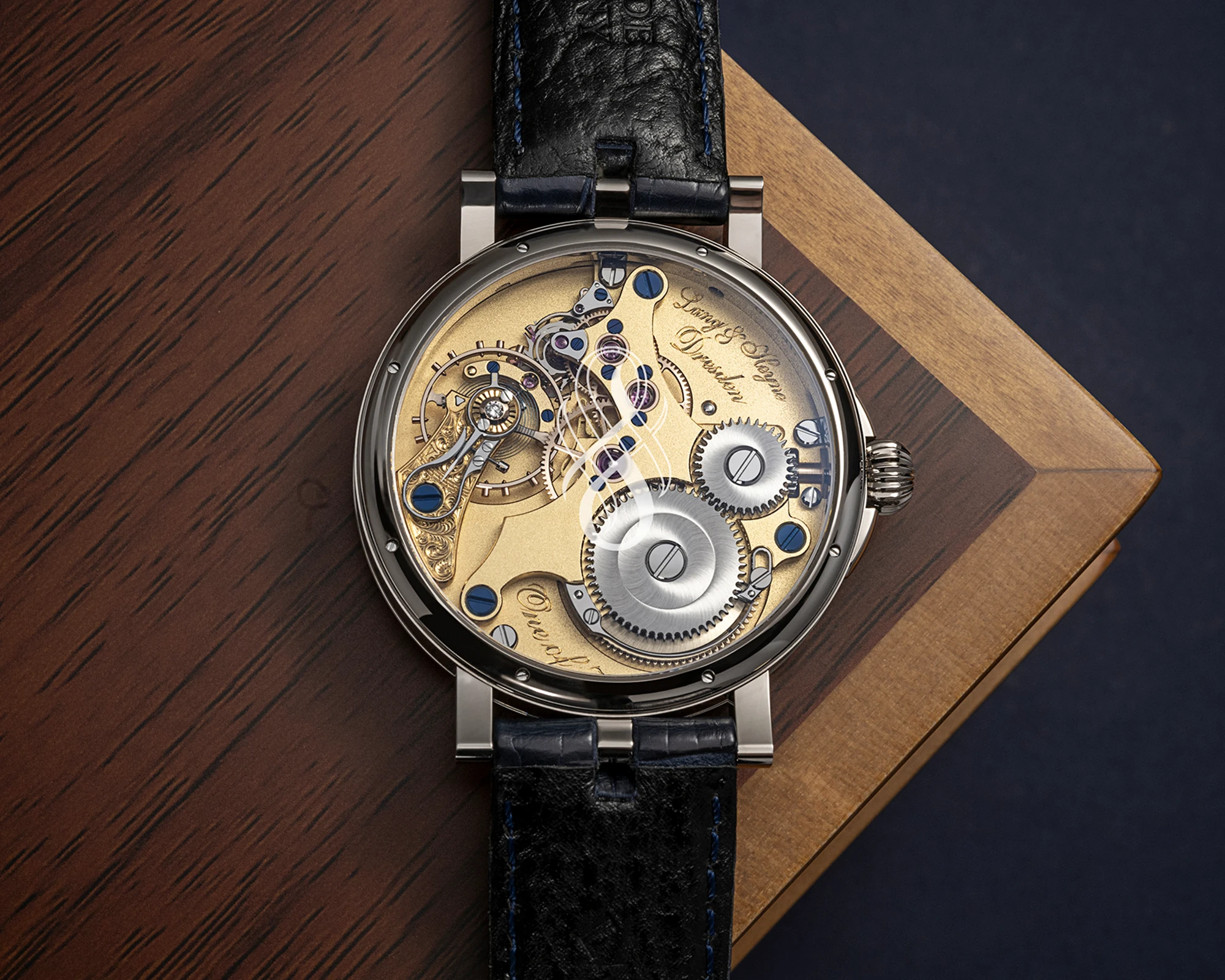
The new edition uses the same Calibre VI-I that was first presented in 2022 in the Friedrich II Remontoir ‘The Lavish Attic’ Edition. However, this edition uses a brass movement instead of titanium. The remontoircomplication, which is located next to the escape wheel, enables controlled power transmission, resulting in an even transfer of energy over the entire power reserve. This complication is also responsible for the jumping seconds on the dial.
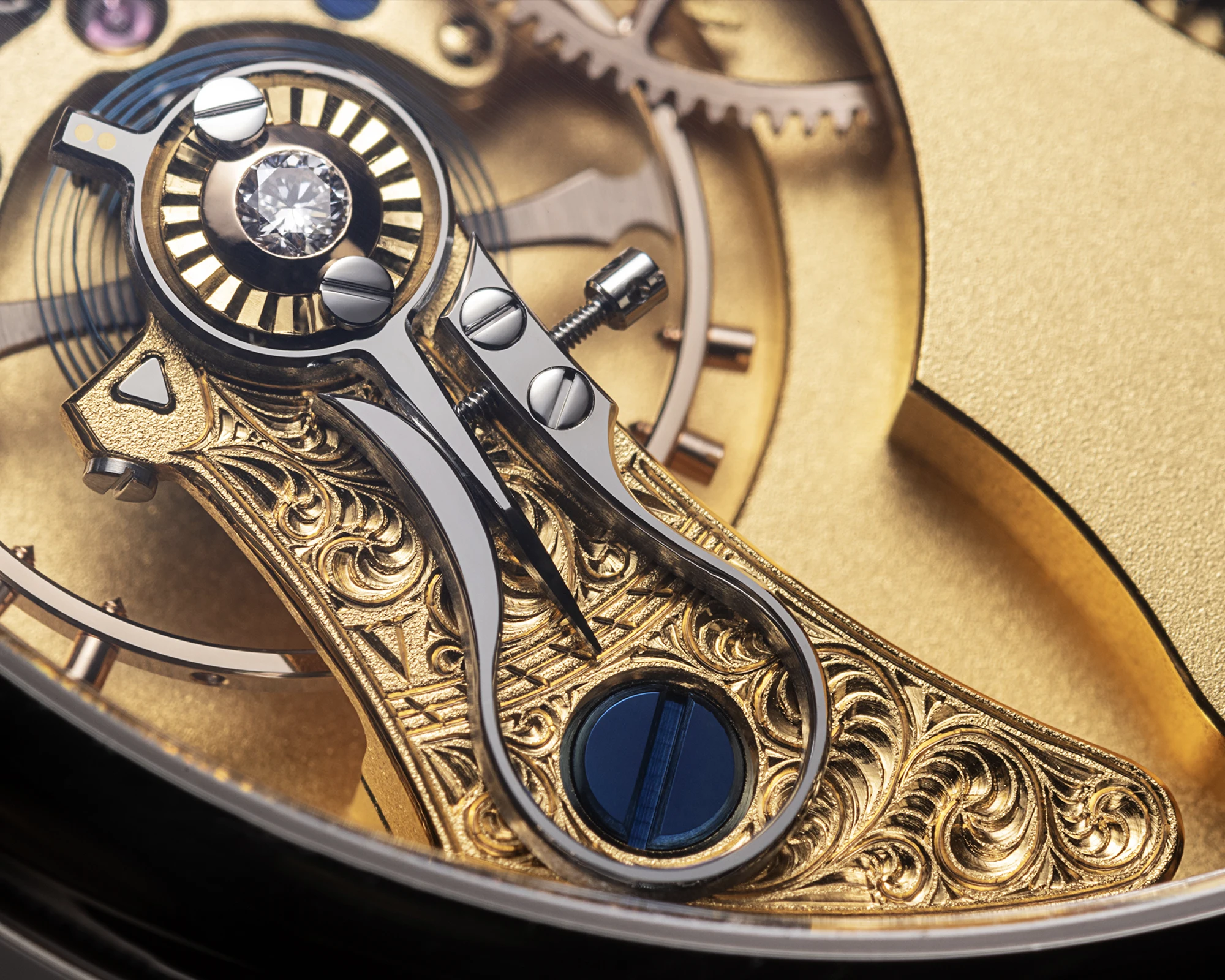
The Friedrich III Remontoir Sincere Platinum Jubilee Edition is worn on a dark blue alligator leather strap.
This is not yet the entire repertoire of individual pieces and special collections from Lang & Heyne. But hopefully, it provides a nice insight and overview of the high craftsmanship and possibilities of a watch manufacture from which we will certainly see many more beautiful watch creations. In any case, perhaps we have been able to inspire you to discover a rather special star in the collector’s sky.





